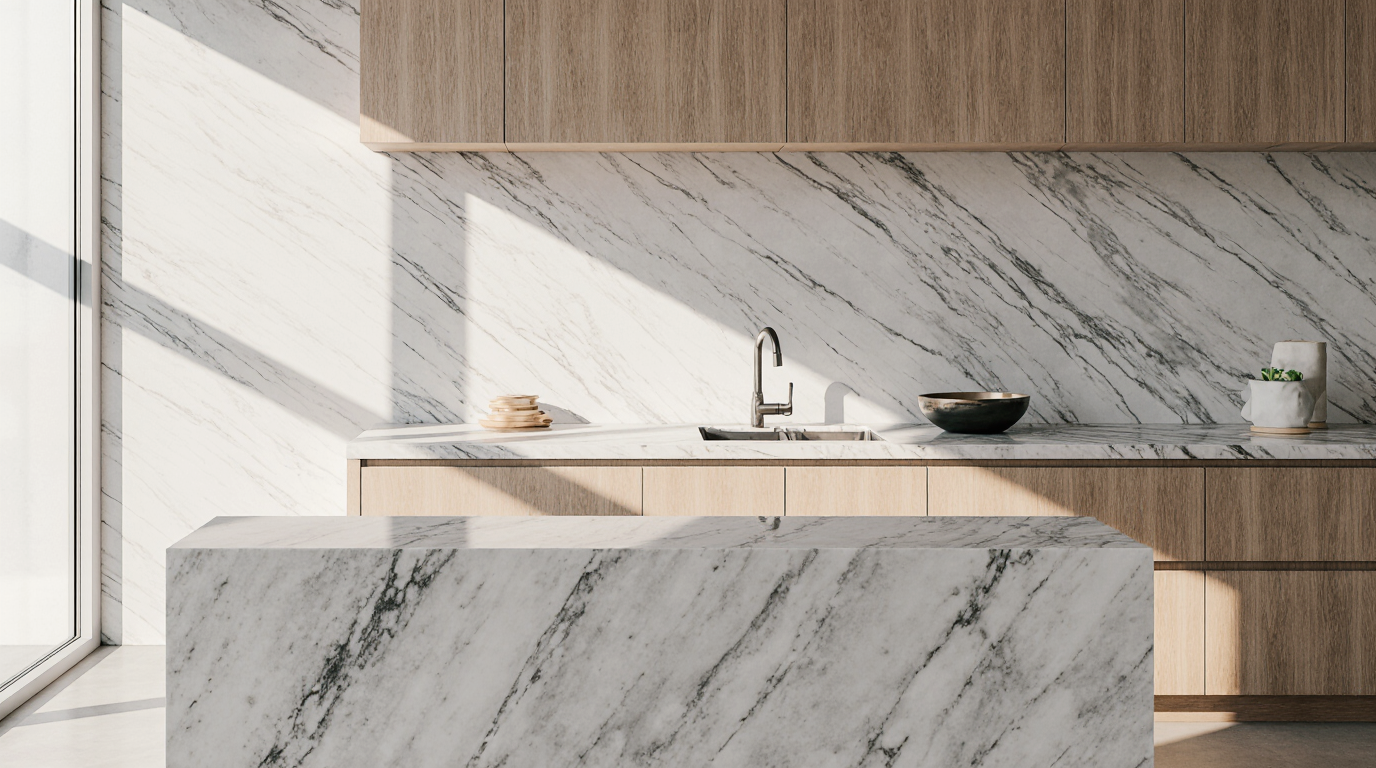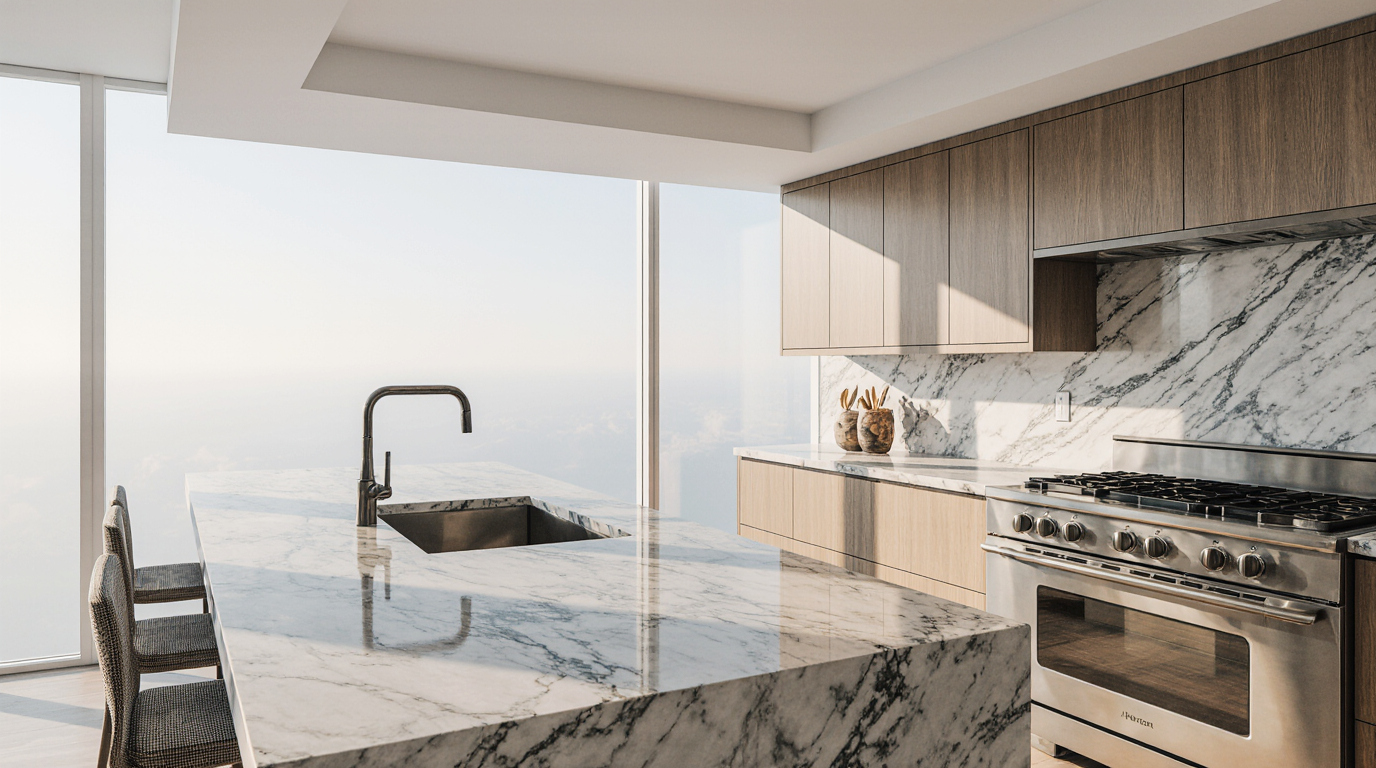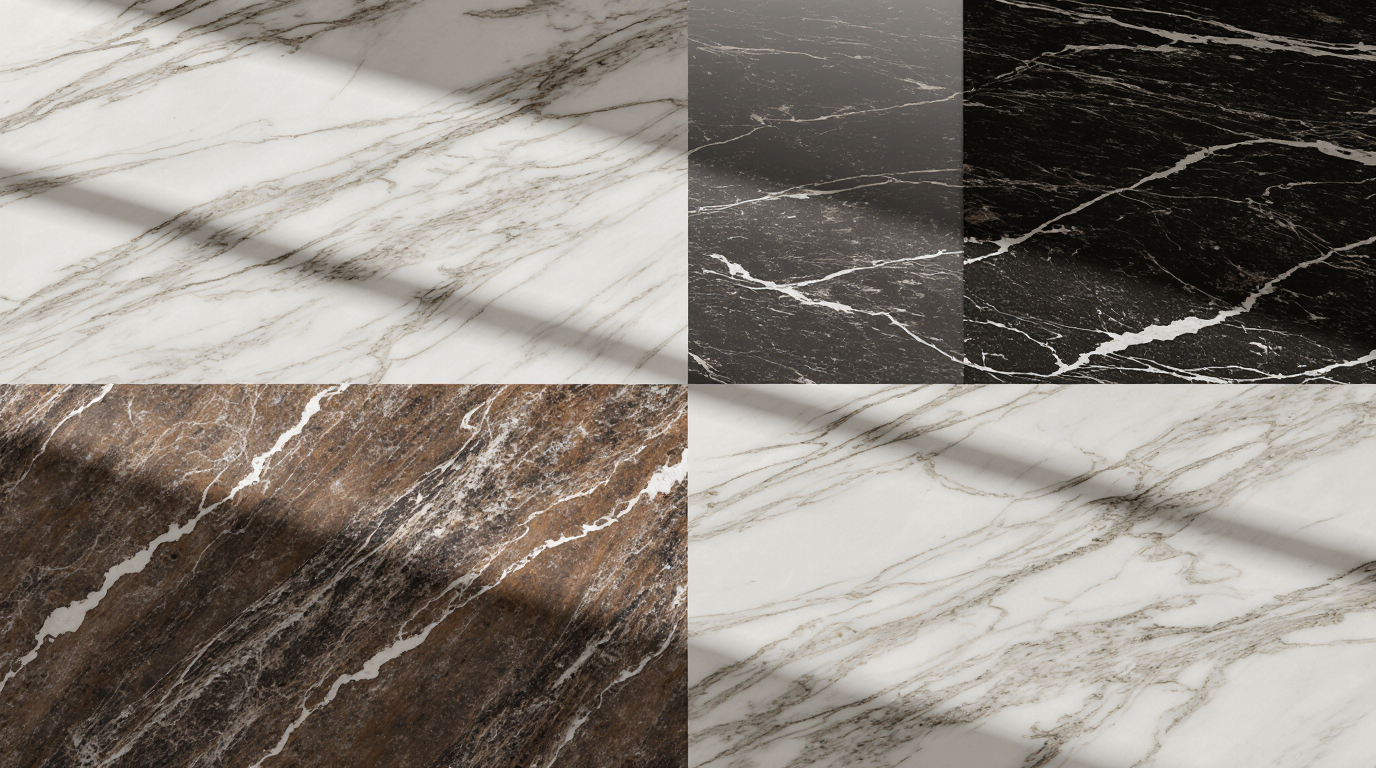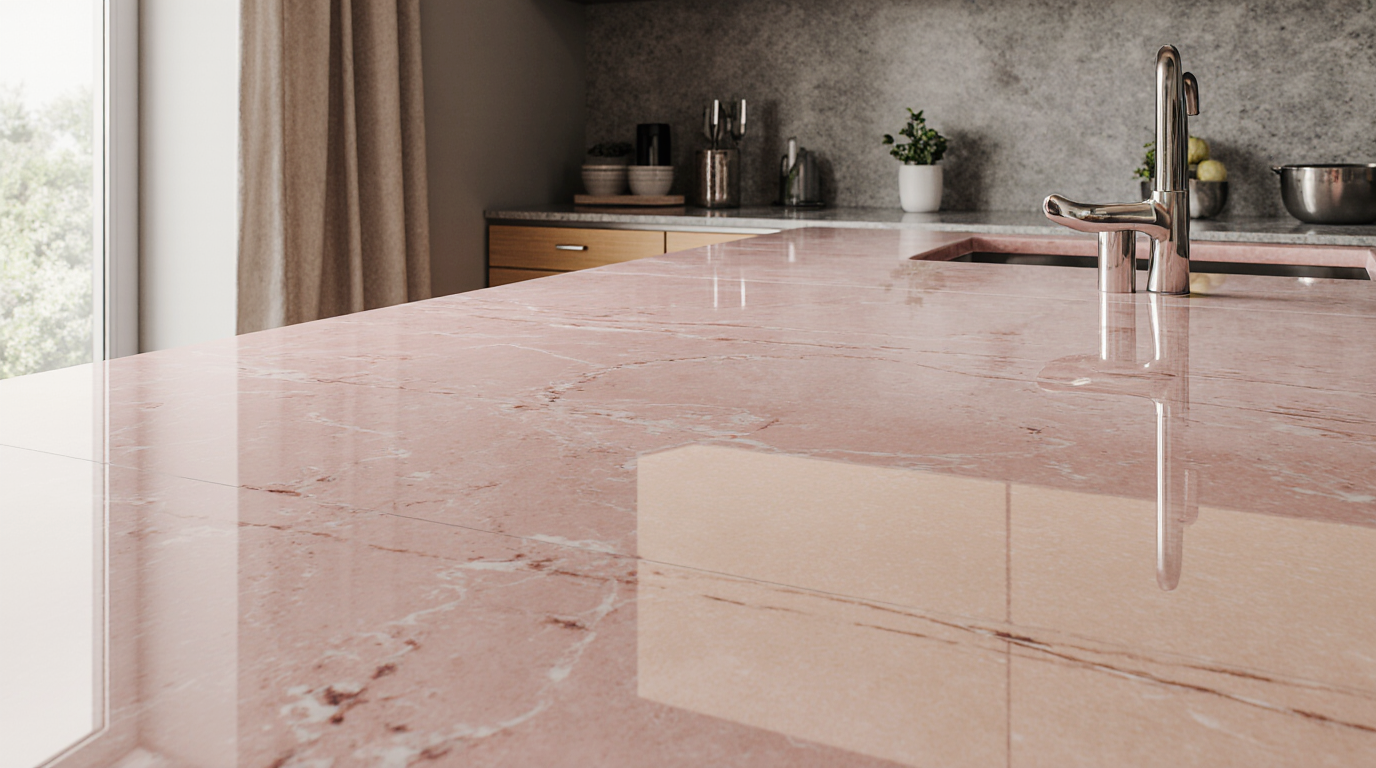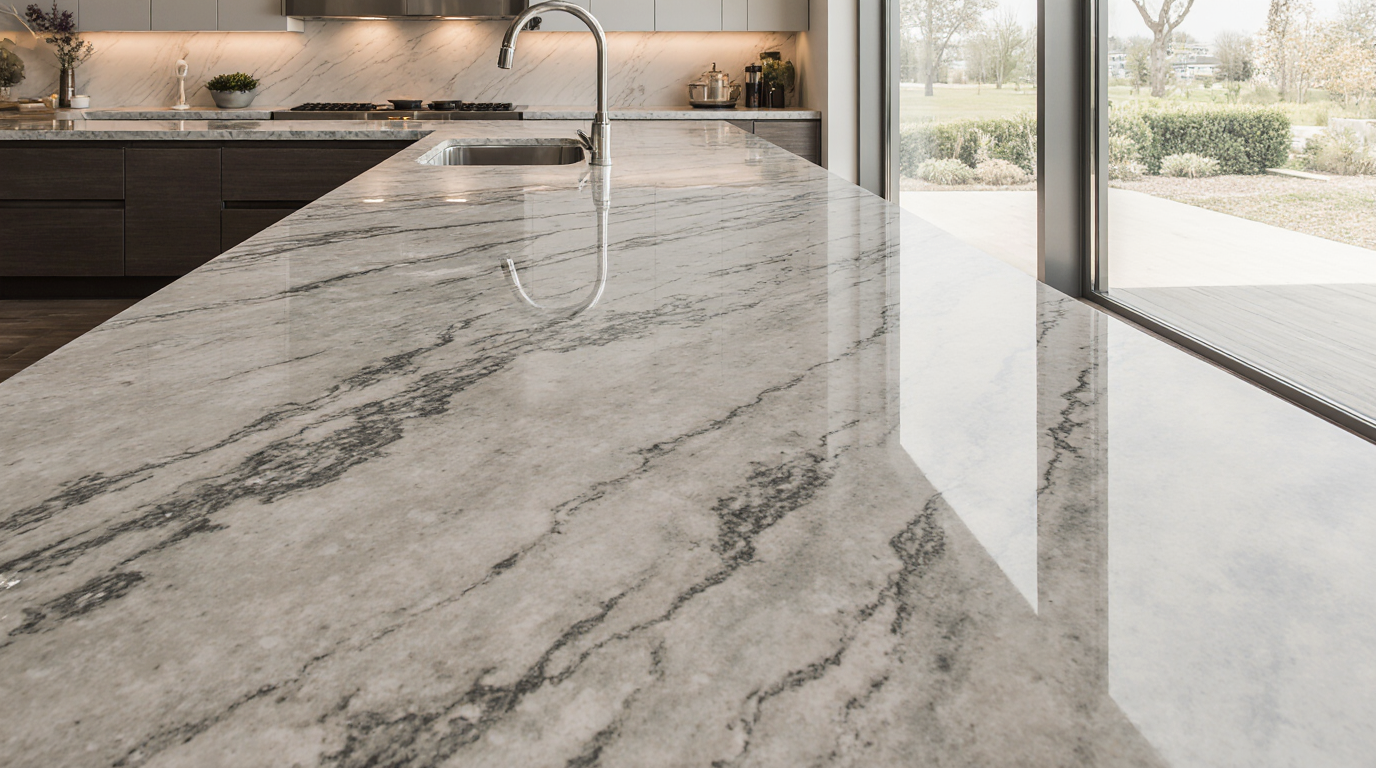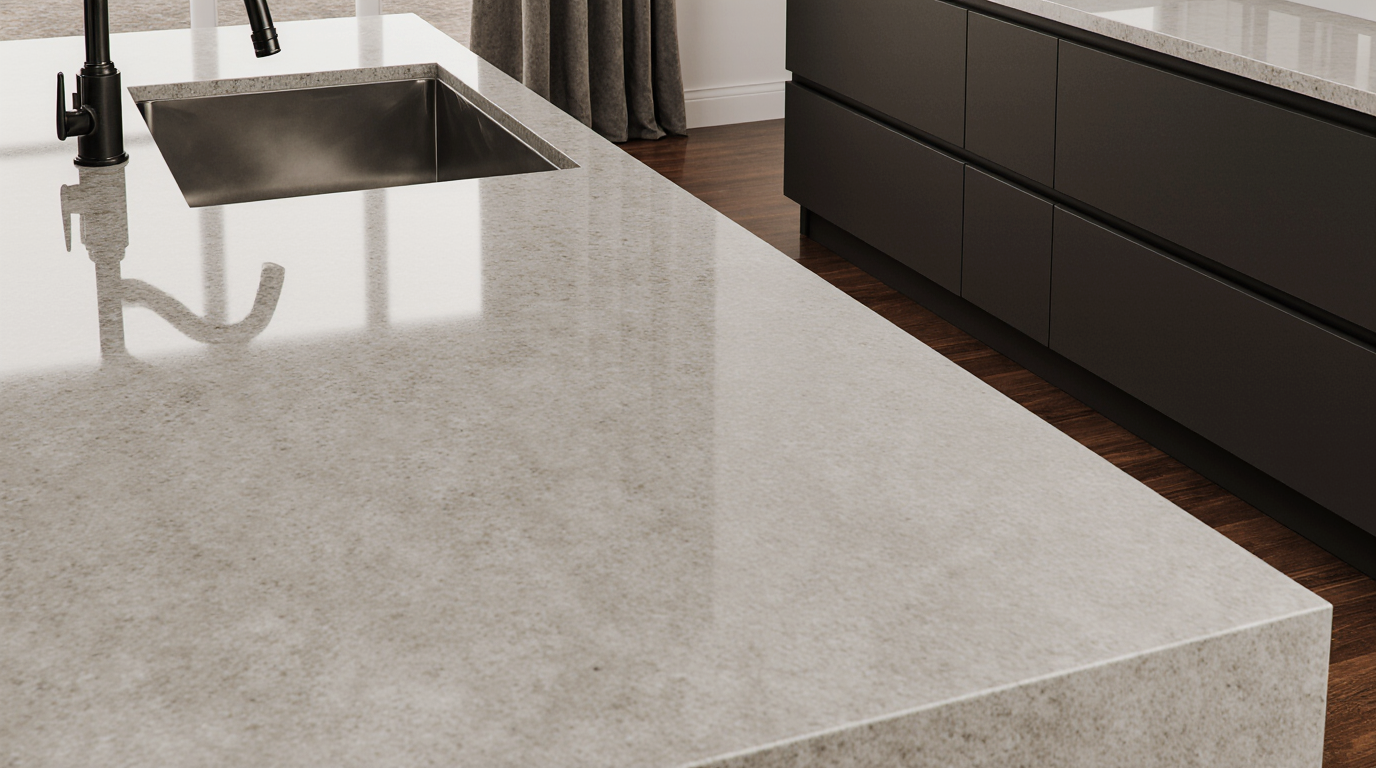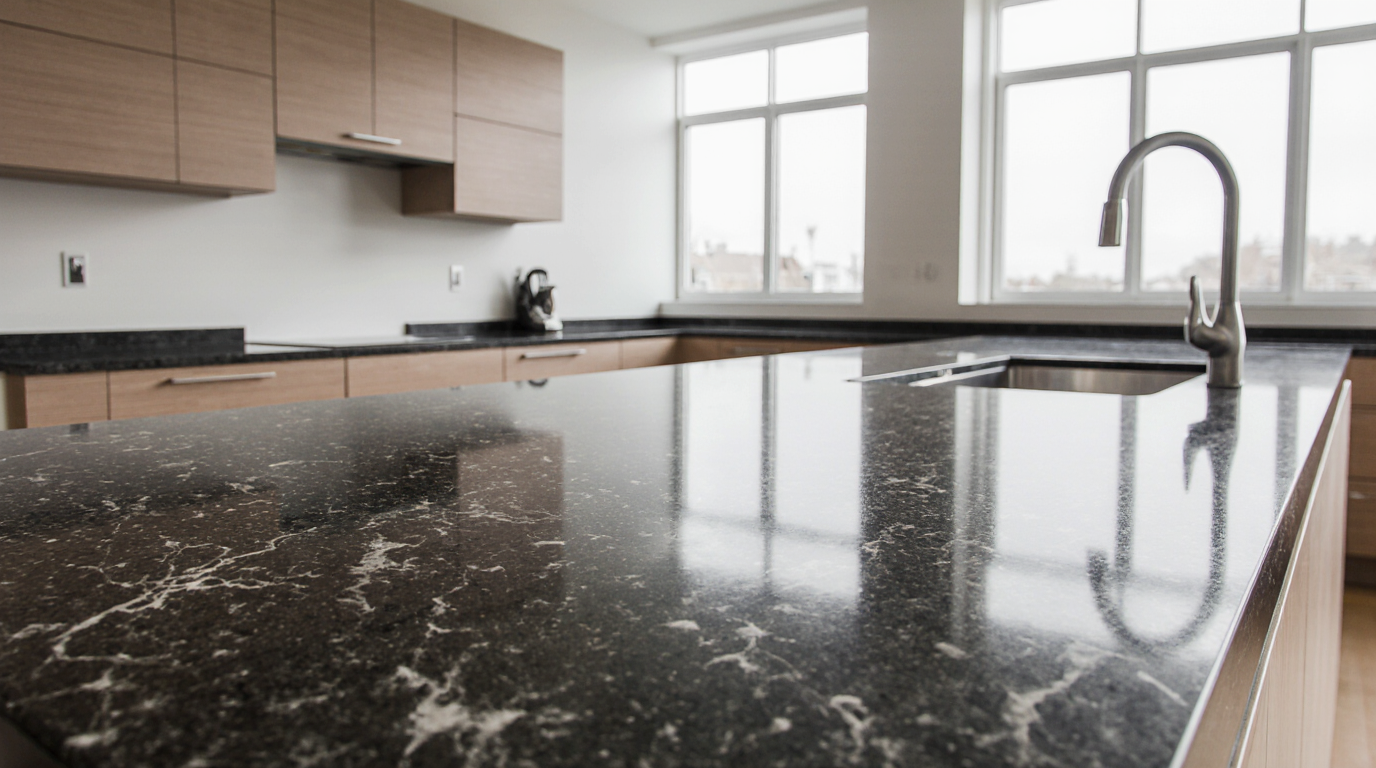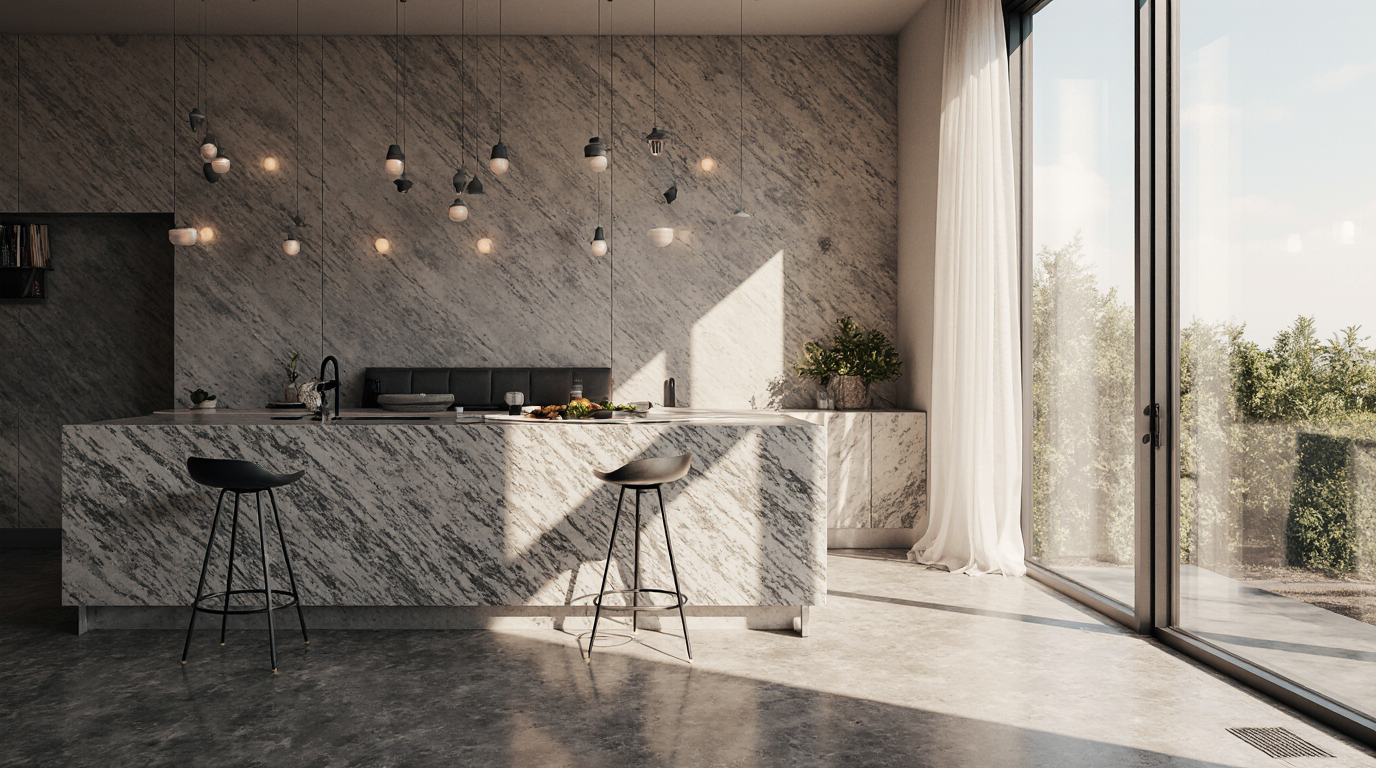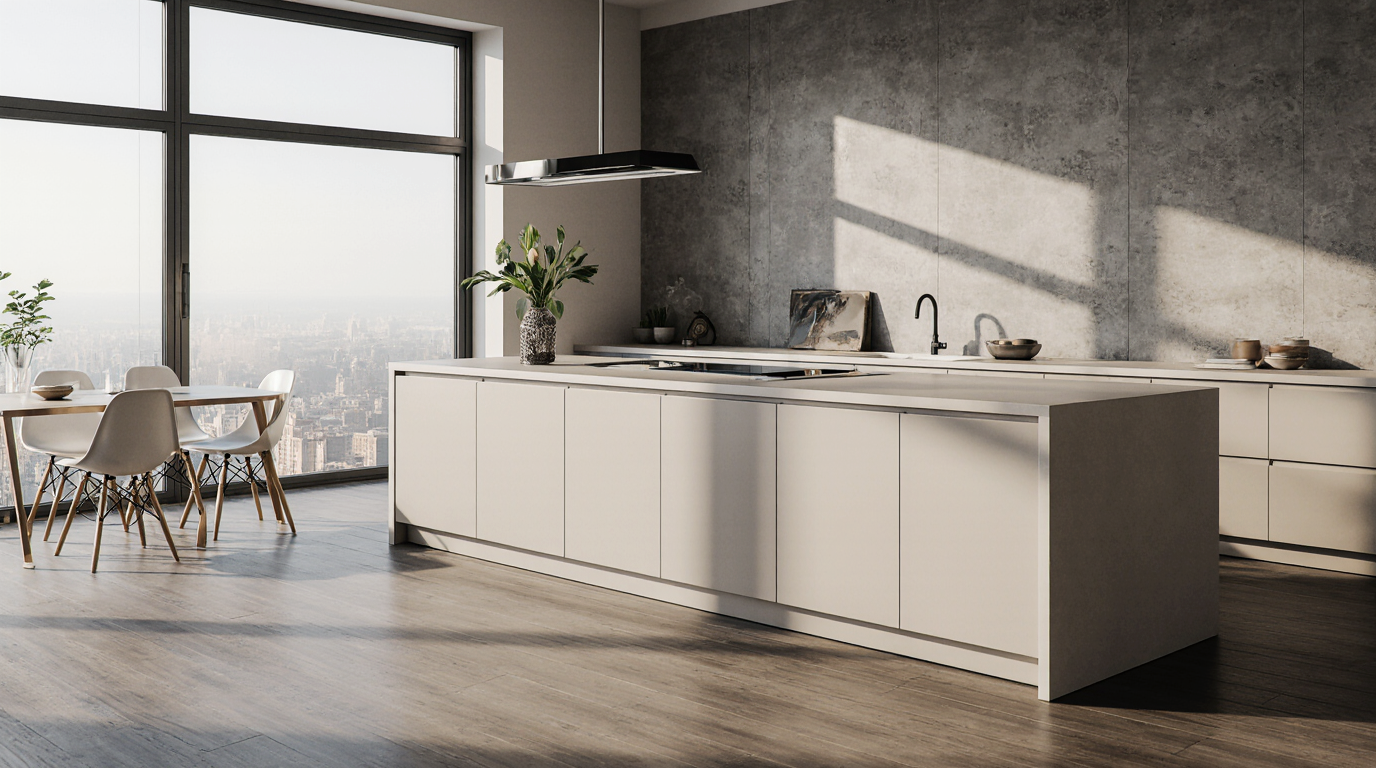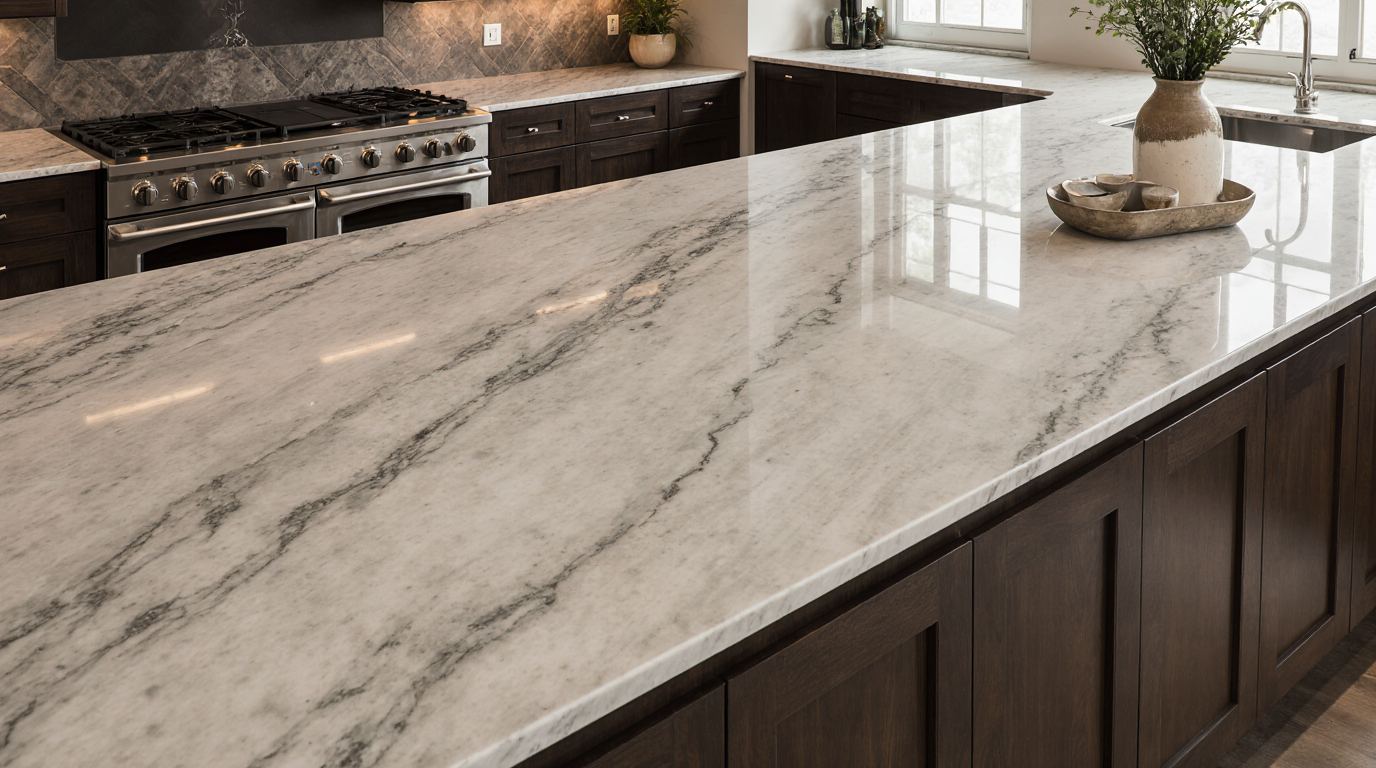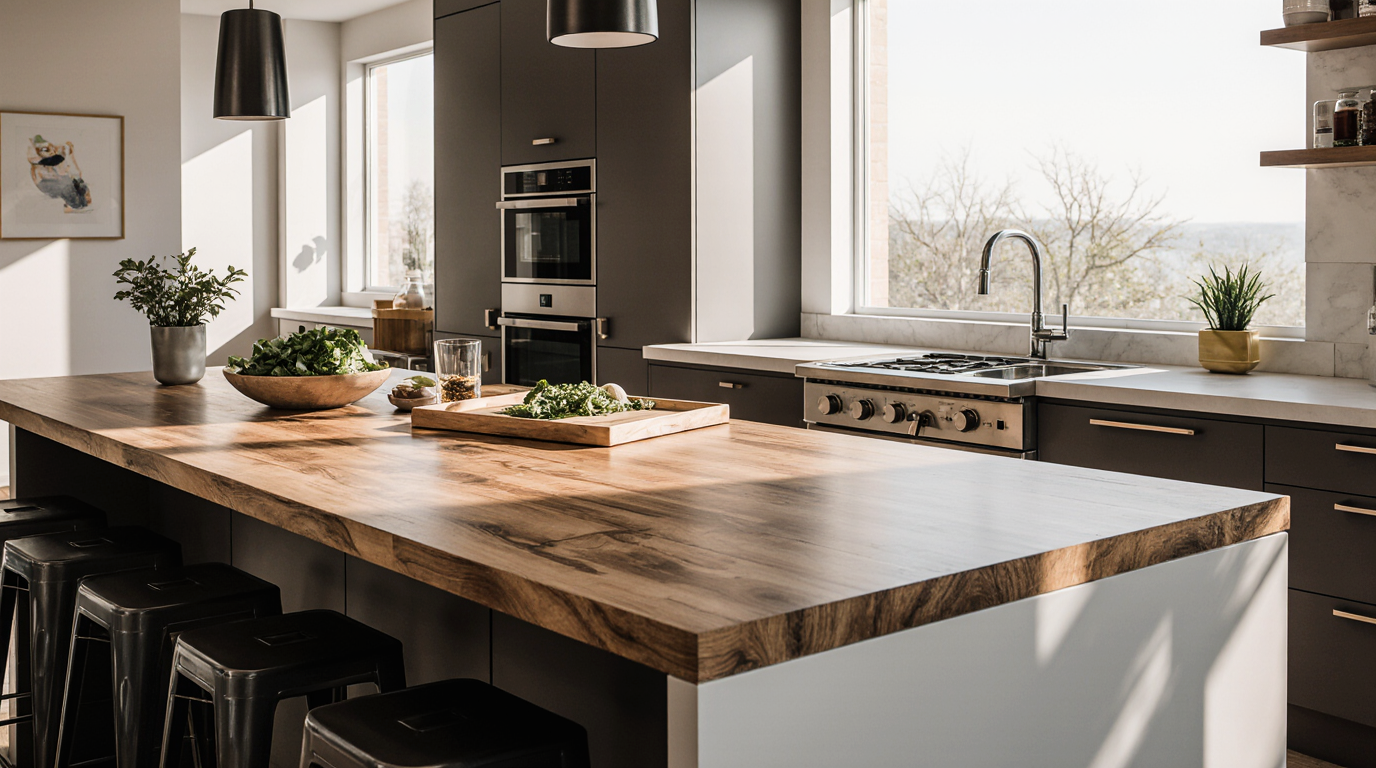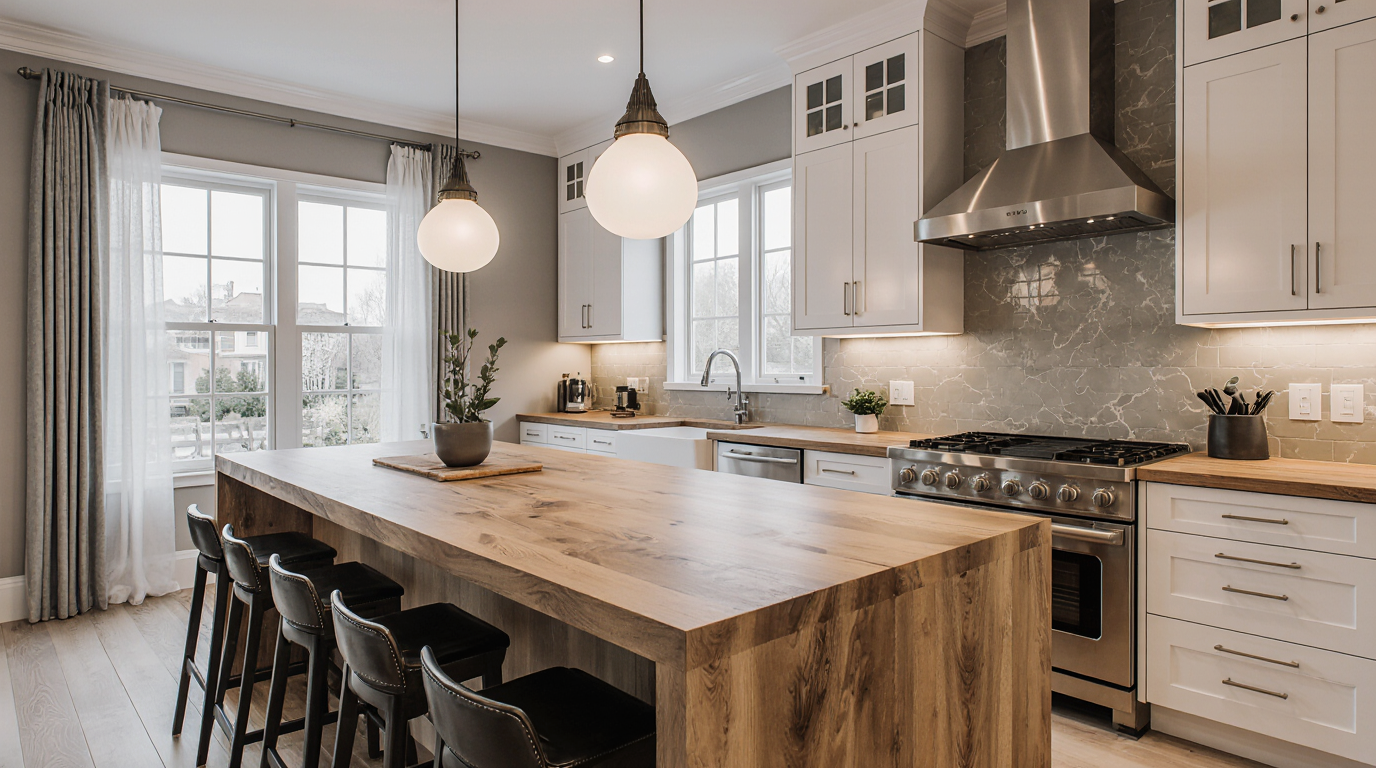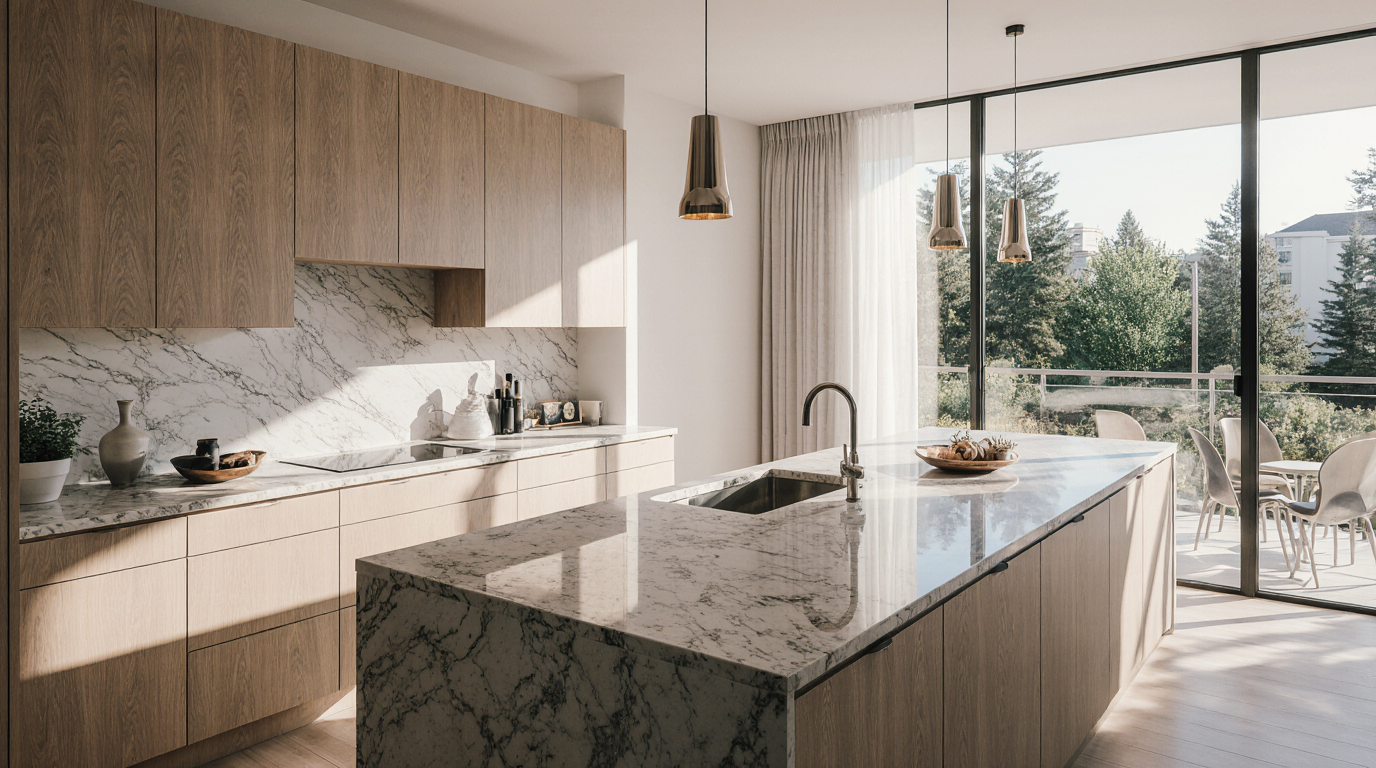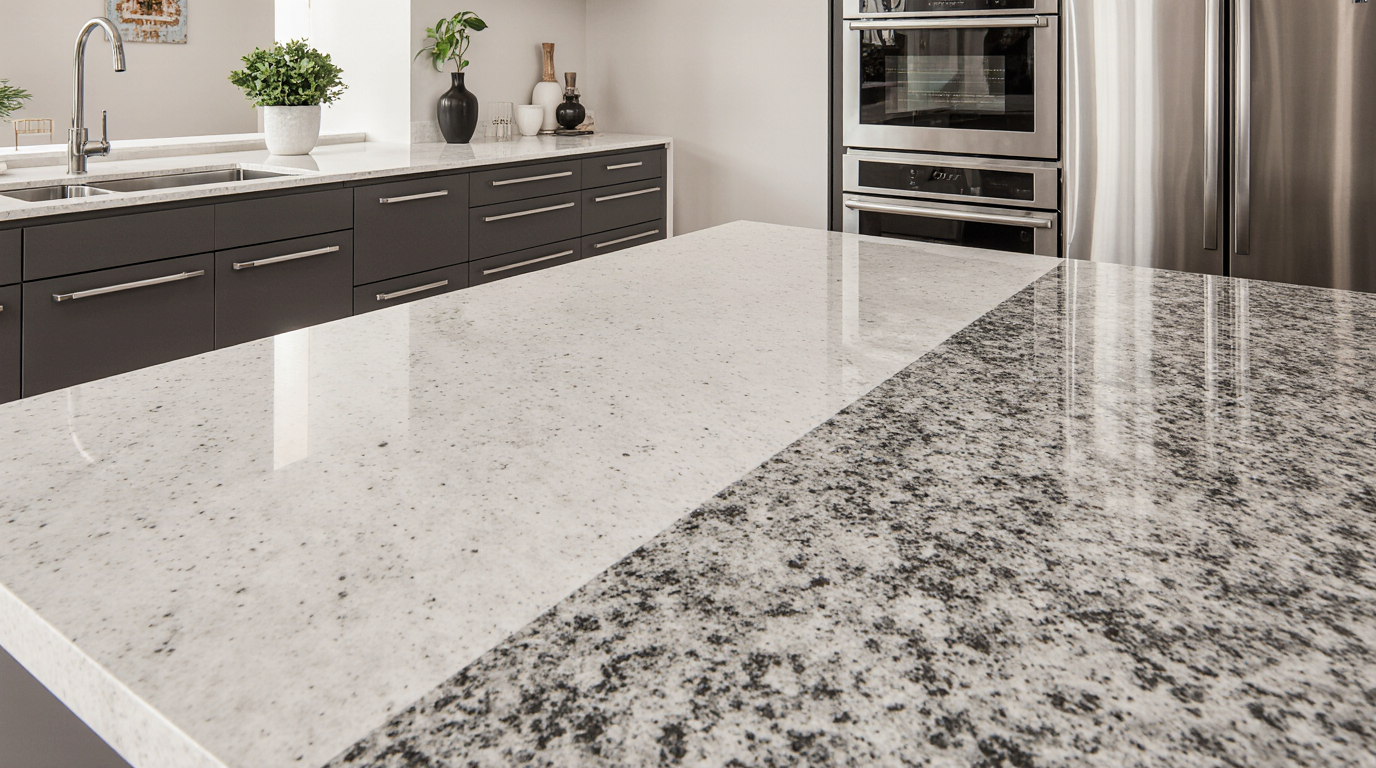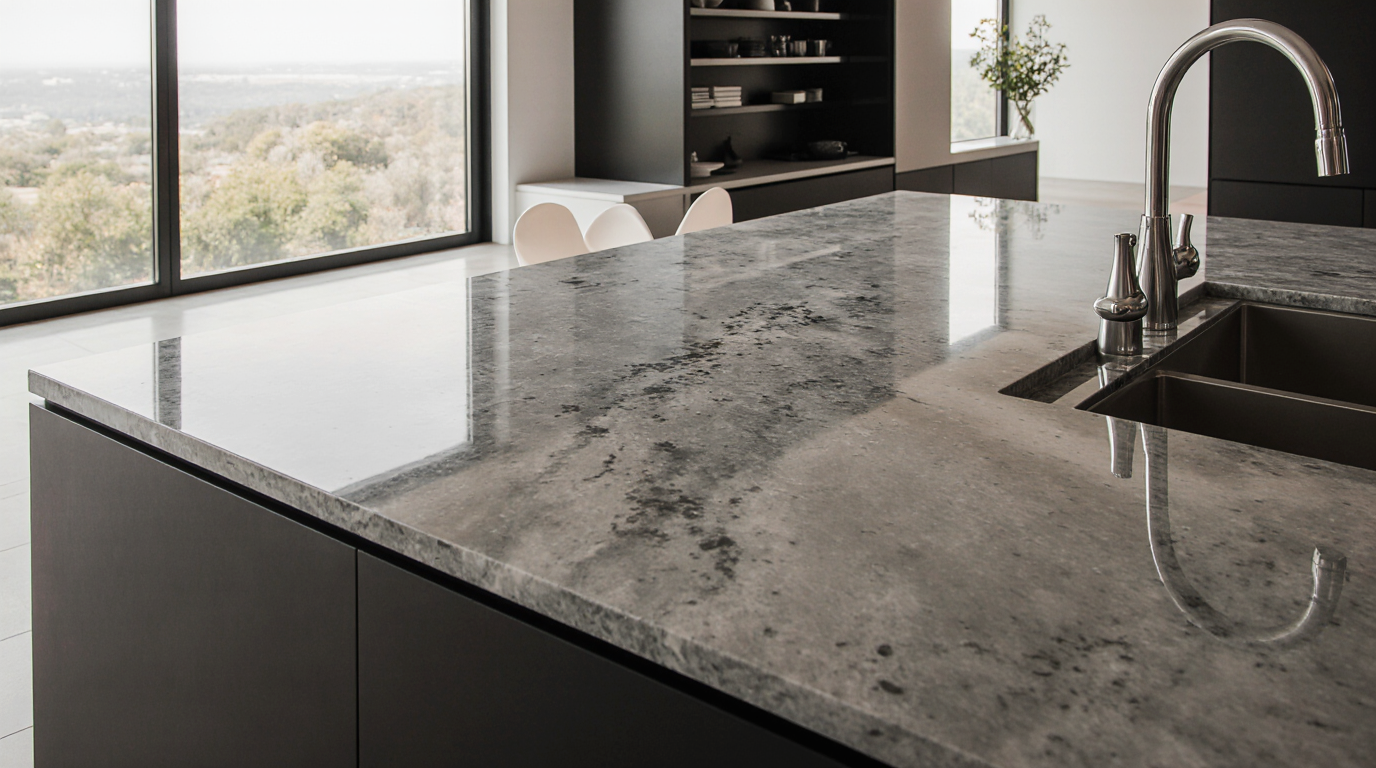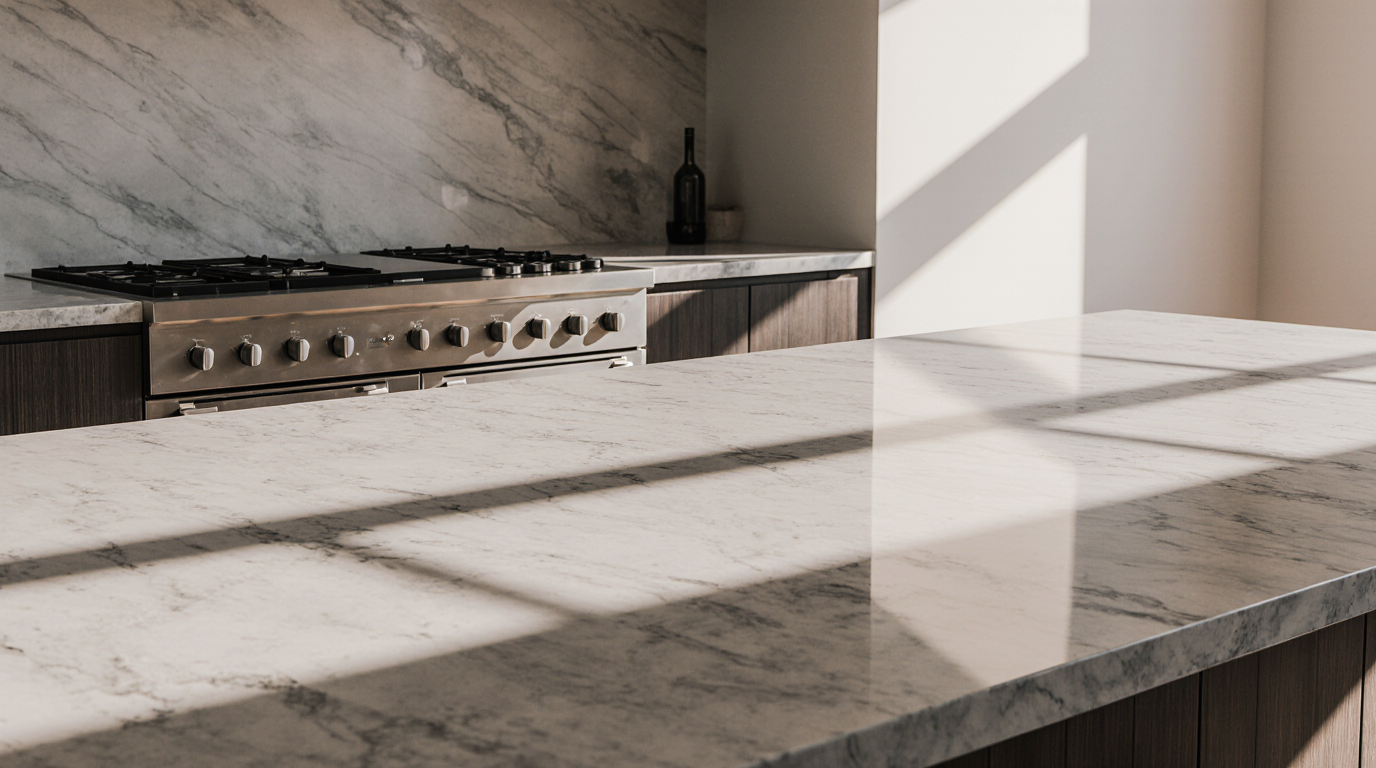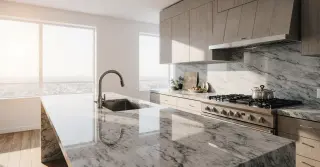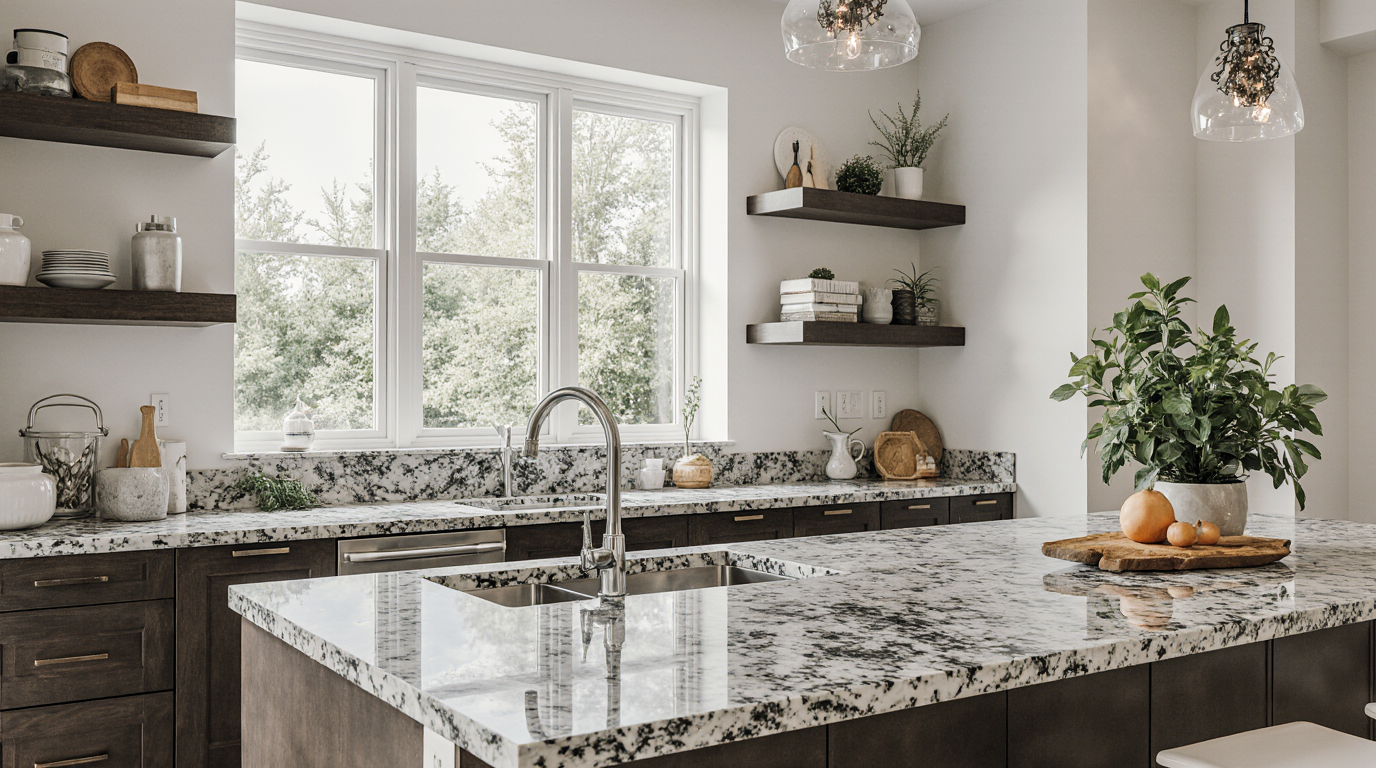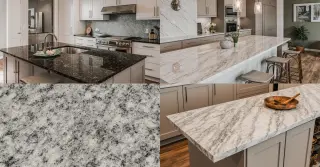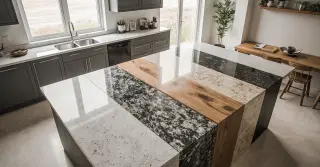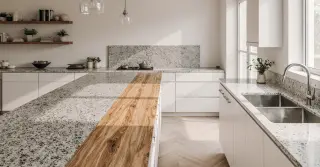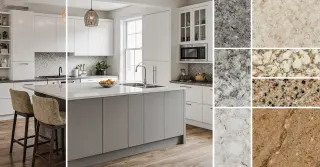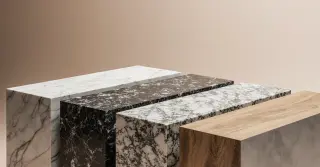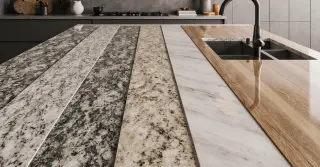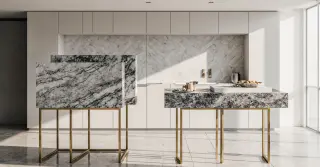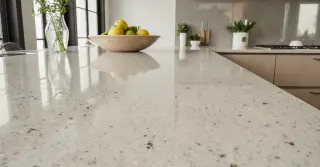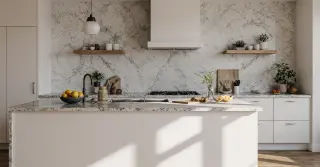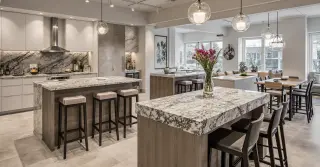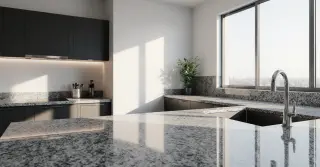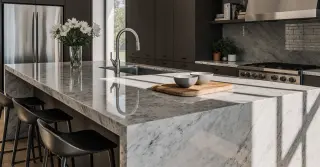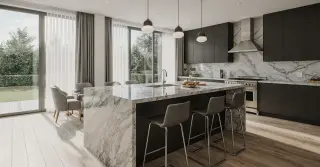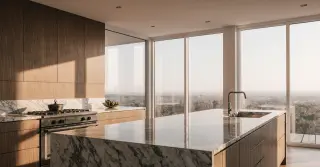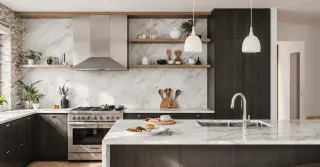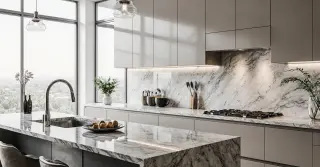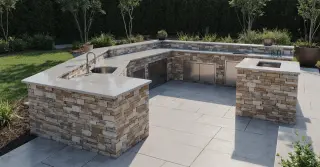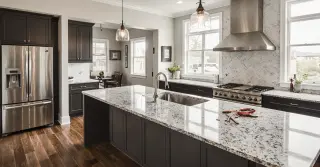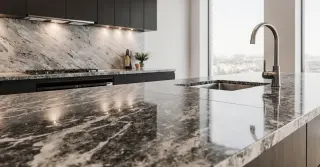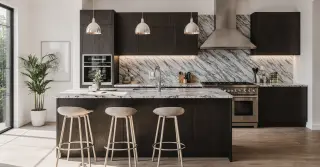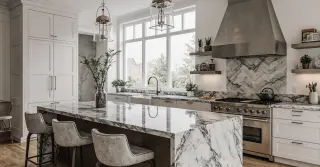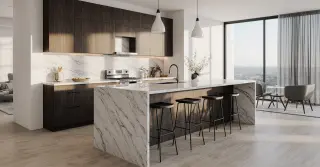Countertops
Choosing the right kitchen countertops is one of the most significant decisions in any kitchen design project, directly influencing both the functionality and aesthetic appeal of your space. These surfaces are arguably the most used element in the kitchen, serving as the primary area for food preparation, daily activities, and social interaction, which means that durability and resistance are paramount factors.
Choosing the right kitchen countertops is one of the most significant decisions in any kitchen design project, directly influencing both the functionality and aesthetic appeal of your space. These surfaces are arguably the most used element in the kitchen, serving as the primary area for food preparation, daily activities, and social interaction, which means that durability and resistance are paramount factors.
Many homeowners aiming for a premium, luxurious finish frequently find themselves drawn to the timeless elegance and inherent character of natural stone choices, including classic materials like granite and marble. Granite, with its reputation for rock-solid durability, distinct crystalline structure, and resistance to common kitchen damage like intense heat and knife marks, stands as a premier material, proving itself to be a worthwhile capital expenditure that reliably enhances the resale value of the property. While marble provides an unmistakable aura of sophistication and historic charm, design experts consistently remind clients that its inherent softness and porosity mean it is prone to damage from acidic substances and color-transferring liquids, making diligent care, including routine professional sealing, essential for preserving its high-end appearance.
For those desiring maximum performance with minimal upkeep, engineered stone, particularly quartz countertops, has become a dominant trend. This stone, which is fundamentally a composite of pure quartz mineral fragments held together by high-performance polymer resins, boasts a naturally non-porous surface, making it supremely resistant to liquid penetration and staining, and thus completely obviating the necessity for any sealing treatments. Quartz demonstrates remarkable resilience against everyday knocks and can be sourced in a dizzying spectrum of finishes, ranging from solid colors to highly accurate replicas of the most sought-after natural stones, offering a breadth of customization options that is difficult to surpass.
We should also consider acrylic solid surface materials, a contemporary solution appreciated for its supreme practicality, especially its capacity for creating a completely unified counter-to-sink installation with non-visible seams, which results in a continuous, flowing surface well-suited to sleek, ultra-modern kitchen environments. Lastly, it would be a mistake to disregard the distinctive, comforting organic beauty of butcher block; these thick wooden surfaces inject a sense of classic, welcoming warmth into any kitchen but do necessitate consistent, scheduled oiling and maintenance to preserve their integrity, water repellency, and deep, lustrous color. Evaluating your lifestyle, budget, and desired kitchen aesthetic will guide you in selecting the ideal surface that harmonizes form and function, truly completing your dream kitchen.
Countertops for SaleSelecting the ideal countertop is a crucial phase in any kitchen or bath remodel. It’s a decision that weighs visual appeal, practicality, and cost, influencing the entire look and feel of your space. If you’re seeking the upscale look of marble, the robust durability of granite, or the contemporary versatility of quartz, the sheer volume of options for sale can be daunting. Understanding the pros and cons of each material is essential to making a purchase that you will be happy with for a long time.
When browsing available countertops, it's wise to consider not only the material type but also the specific slab or design. Natural stone, such as granite and marble, is truly unique; no two slabs are exactly alike, offering an inherent exclusivity to your design. However, quartz and other man-made options, while offering a uniform look and greater resistance to staining, provide a wider range of consistent colors and patterns. Be sure to visit displays or examine large material pieces to appreciate the true color variations and veining before making a final purchase.
The purchasing process should also factor in fabrication and installation. Many countertop sales include the material only, with cutting, edging, and installation being separate costs. Demand a detailed, all-inclusive quote that outlines the entire process, from templating your cabinets to the final sealing (if required for your chosen material). This transparency is crucial for managing your total project budget and timeline effectively. A reliable vendor provides accurate measuring and expert installation, guaranteeing a perfect fit and finish.
Furthermore, do not overlook the importance of finding a local supplier who can offer personalized advice and support. A local "for sale" option often means better communication, more rapid service, and the ability to inspect the actual slabs in person. Prioritize vendors who have strong reviews and a track record of quality craftsmanship. Investing time in finding the right product and partner will ensure your countertop purchase transforms your kitchen into the functional, beautiful space you envision.
Design CountertopsDesigning the ideal countertop goes far beyond simply selecting a color; it involves a sophisticated interplay of material, edge profile, thickness, and overall kitchen design. The countertop is the functional centerpiece of the kitchen, and its design must seamlessly integrate with the cabinetry, backsplash, and flooring to create a cohesive and appealing environment. A well-designed countertop enhances workflow and significantly elevates the room’s aesthetic value.
The edge profile is a key design element that can drastically alter the final look. For a modern, minimalist feel, a simple eased or straight edge is often chosen. On the other hand, a more classic or conventional kitchen might look better with an elegant bevel, ogee, or bullnose edge, adding a layer of detail and softness. Also, keep in mind the utility of the edge; rounded edges are generally safer and easier to clean, while sharp edges can accumulate dirt more easily but offer a sharp aesthetic.
Material choice is another foundational aspect of countertop design. The pattern and color you select should complement the existing color palette of your kitchen. For instance, if your cabinets are dark, a lighter-colored countertop can create striking contrast and brighten the room. If your kitchen features a bold backsplash, a more subdued, solid-colored countertop material might be the better design choice to allow the backsplash to remain the focal point.
Aside from appearance, smart design requires detailed layout consideration. This means carefully considering the placement of seams, if necessary, and ensuring adequate overhang for comfortable seating at islands or peninsulas. A skilled designer or fabricator can help you manage these detailed design elements, ensuring structural integrity and a high-end, bespoke finish. A successful countertop design strikes a perfect balance between stunning visual appeal and robust, daily usability.
Countertop Replacement CostGrasping the complete cost of replacing your countertops is crucial for a smart home improvement budget. The price of replacing old countertops is not a single, fixed figure, but rather a sum of various elements, the most significant being the choice of material. Materials like entry-level laminate will be at the lower end of the spectrum, while high-end natural stones such as exotic granite or premium marble will cost considerably more.
Beyond the raw material, several other factors contribute significantly to the total replacement cost. Fabrication and installation are major components, often calculated based on the difficulty of the work. A kitchen with complex cuts, non-standard shapes, or big islands necessitates greater effort and thus a higher expense. Additionally, factors like the edge finish (detailed profiles incur higher fees), the number of sink cutouts, and specialized finishing treatments can impact the total estimate.
The costs associated with removing and disposing of your old countertops are also essential to include in your financial planning. Certain fabricators may incorporate this work in their estimate, but others bill it as a distinct fee. Furthermore, surprise charges, such as the need for minor cabinet modifications to accommodate a different countertop thickness or the cost of temporary plumbing disconnections, should be anticipated to avoid budgetary surprises.
To get the most accurate estimate for your specific project, you should gather quotes from at least three different, reputable fabricators. As you review estimates, verify they cover the identical amount of work—including the precise material, measurements, edge detail, and labor provided. A detailed, all-inclusive quote is the best way to accurately predict the full countertop replacement cost and begin the work with certainty.
Black Countertop Kitchen DesignSelecting black surfaces is a traditional yet bold choice that quickly imparts a kitchen with a sense of drama, sophistication, and modernity. They offer a striking contrast that grounds a room and offers an excellent base for lighter cabinetry or metallic fixtures. The appeal of a black countertop lies in its versatility; it works perfectly in modern, urban, and even more conventional kitchen styles.
One of the most compelling aspects of black countertops is how they interact with other design elements. When paired with white or light-grey cabinets, they create the classic, distinct two-tone appearance that is constantly trendy. For a warmer, richer feel, a black countertop with wood cabinetry—especially those with warm undertones—offers a luxurious, natural aesthetic. Using black as the dominant color on your surfaces makes metallic accents, such as brass pulls or stainless steel appliances, truly pop.
Material texture is critical when designing with black surfaces. A polished black granite or quartz countertop will reflect light, adding a layer of depth and shimmer. In contrast, a honed or matte black finish provides a more muted, velvety appearance that can minimize reflections and fingerprints, offering a refined, modern urban style. The subtle texture of the material can significantly impact the final mood of the kitchen.
To prevent a kitchen with black countertops from feeling overly weighty or gloomy, incorporate ample lighting. Under-cabinet lighting is essential to illuminate the work surface, and stylish pendant lights can add visual interest above an island. Furthermore, a light-colored or reflective backsplash can balance the weight of the dark counters and add necessary brightness. Smart selection of materials and light combinations will make your black surface design an impressive highlight, not a shadowy spot.
Cost of Changing Kitchen CountertopsChanging kitchen countertops is one of the most impactful upgrade you can make to your home, drastically improving both the utility and home value of the space. The financial investment, however, is multifaceted, encompassing more than just the price of the new slab. It’s crucial to determine the true cost of changing your countertops by considering the full lifecycle of the project, from demolition to completed installation.
The primary source of the total cost is, invariably, the choice of material. Popular options like mid-range granite and engineered quartz generally offer a great mix of durability and aesthetic appeal at a mid-level cost per square foot. More budget-conscious options include quality laminate, while premium materials such as exotic quartzite, specialty concrete, or recycled glass will sit at the top level of the price range. The cost difference between materials can easily shift the total project budget by a substantial amount.
Labor is a significant, yet often underestimated, expense in the cost of changing countertops. This includes the professional labor required for templating (taking an exact measurement of your cabinets), cutting the material, fabricating the desired edge, and the last, rigorous installation. If your kitchen requires adjustments to accommodate the new counters—such as leveling old cabinets or minor wall repair—these additional labor hours will add to your final invoice.
Finally, don't forget the peripheral costs associated with the change. This may include a new sink and faucet if the existing ones are not compatible with the new counter material or cutout. There is also the cost of removing and properly disposing of your old material, which requires specialized handling. By gathering detailed quotes that itemize the material, fabrication, and installation, you can accurately budget for the cost of changing your kitchen countertops and ensure a trouble-free renovation process.
Quartzite Outdoor CountertopsQuartzite has become a highly desirable material for outdoor kitchen countertops, bridging the gap between exceptional durability and the stunning aesthetic of natural stone. As an exterior surface, it must endure environmental challenges such as fluctuating temperatures, direct sunlight, and moisture, all while maintaining its beauty and structural integrity. High-quality quartzite, a metamorphic rock, offers a great solution by providing a surface that is both resilient and visually captivating, often featuring complex veining that rivals the look of marble but with superior hardiness.
One of the most significant advantages of choosing quartzite for an outdoor space is its remarkable UV resistance. Unlike some engineered quartz products, which can fade or yellow when exposed to prolonged, direct sunlight, natural quartzite remains color-stable, preserving its original beauty for years. This makes it a smart, lasting investment for patios and open-air cooking areas where the countertop is a focal point. Additionally, its high ranking on the Mohs hardness scale (typically 7 out of 10) means it is resistant to scratching, a common concern in high-traffic outdoor food prep zones.
However, selecting quartzite for the outdoors is not without its considerations, primarily regarding maintenance. While naturally hard, quartzite is porous and must be properly sealed upon installation and on a regular, often annual, basis. This sealing process is critical to preventing stains from spills like wine, oil, or acidic barbecue sauces, which can otherwise penetrate the stone. Failing to perform this maintenance step can lead to permanent discoloration and compromise the stone’s hygiene, especially in food preparation areas.
Another factor is the cost and installation complexity. Quartzite is often priced similarly to high-end granite or marble, and its extreme density and weight make it tough to fabricate and install. This is not a material for a DIY enthusiast; professional installation by skilled craftsmen with specialized tools is highly recommended to ensure proper fit, alignment, and long-term durability. When planning your outdoor area, budgeting for this specialized installation is just as important as the cost of the slab to guarantee a immaculate finish that can withstand the elements.
Types of Kitchen Countertops by PriceWhen renovating a kitchen, the price point for work surfaces is often a crucial element influencing the selection process, with options spanning an immense range from cost-effective solutions to exclusive, high-end choices. Understanding the different tiers allows homeowners to harmonize financial constraints with their design vision and functional requirements. At the most budget-friendly end of the scale are materials like laminate and ceramic tile, which offer great versatility in color and pattern, with laminate being among the most straightforward to fit, requiring a very small initial financial outlay.
Moving into the mid-range price bracket, homeowners come across materials like solid surface composites and the trending option of solid wood butcher block. Solid surfaces, like Corian, are non-porous and seamless, offering excellent hygiene and easy repairability, while butcher block delivers an organic, inviting aesthetic. These two choices achieve a fine balance between durability and price, though they necessitate varying levels of care—solid surfaces being lower maintenance and wood requiring regular oiling to prevent drying and cracking.
The high-end category is dominated by materials such as granite and quartz, alongside other natural rock selections. Engineered quartz, composed of natural quartz aggregate bound with polymers, is highly regarded for its unwavering toughness, uniformity, and resistance to liquid penetration, making it highly stain-resistant and easy to maintain without sealing. Granite, a classic rock option, is unaffected by high temperatures and features unique, irreplicable designs, though it necessitates regular application of a protective sealant. These premium materials command a higher price due to their raw material costs, fabrication complexity, and longevity.
In the ultra-premium cost bracket, you find rare and exceptional natural rocks such as premium marble or specialized quartzite, as well as custom-fabricated alternatives like polished stainless steel or specialized concrete blends. These materials are selected primarily when distinctive beauty and exclusive design are paramount. For example, marble provides an unmatched luxurious elegance but demands the most careful maintenance to avoid etching and staining, validating its expense based on its visual appeal rather than its intrinsic toughness. Ultimately, a strategic approach often involves using a costlier material on a focal point, like a kitchen island, and a more budget-friendly option on perimeter counters.
Black Kitchen WorktopsBlack kitchen worktops are a timeless design element that injects a sense of drama, sophistication, and modernity into any culinary space. The strength of the black finish is its potential to stabilize the overall design, offering a striking opposition when set against pale walls and brighter cupboards, or achieving a seamless, uniform appearance when matched with darker materials. This selection of shade is immensely adaptable, fitting seamlessly into various design styles, from minimalist Scandinavian aesthetics to high-contrast traditional looks.
Among the top contenders for a dark work surface is engineered quartz, which allows for a deep, consistent black shade and a variety of finishes, from matte to high-gloss. A matte black quartz surface provides a chic, contemporary look that minimizes reflection, while a highly reflective surface enhances brightness and provides a sense of visual depth. For those who have an affinity for organic options, black granite and black soapstone are superb alternatives. Black granite typically showcases small, dispersed specks of color or shimmer, giving it a distinctive feel, and soapstone delivers a gentle, tactile warmth that gains a desirable, evolved surface character over years.
Choosing a black worktop can also be a clever design strategy for compact culinary areas. When combined with vivid white or brightly shaded joinery, the black surface can serve as a bold separator that clarifies the kitchen's spatial definition, making the overall space feel more intentional and less cluttered. Furthermore, the dark color is highly effective at concealing minor messes and splatters, a practical advantage in a busy kitchen environment.
Nevertheless, making the correct choice regarding the black counter's surface texture is crucial. While aesthetically striking, polished black finishes have a tendency to highlight finger marks, fine debris, and small scratches to a greater degree than matte textures or light-colored counterparts. Homeowners should reflect on their habits and capacity for regular cleaning when deciding on the surface. Opting for a honed or matte finish, or a granite with complex patterns, can help lessen the prominence of everyday scuffs and marks while still retaining the profound elegance that only a black countertop can deliver.
Kitchen Island Butcher Block CountertopA solid wood counter on a kitchen island is a timeless option that introduces an inviting feel, a tactile surface, and a functional work surface to the heart of the home. Made from thick wooden planks glued together, this style of worktop highlights the natural wood patterns and is in high demand for its natural charm and traditional charm. This material is exceptionally practical that provides the key benefit of being an real surface for cutting, allowing for direct food preparation.
This worktop’s charm extends beyond its appearance to its unique performance characteristics. Wood is naturally porous, but when correctly treated with board cream or mineral oil, it is sealed against liquids and develops a soft, almost cushioned feel that is easy on knives. In addition, different from hard materials, wood is easily repairable. Small blemishes, nicks, or superficial damage can often be lightly refinished and the area re-oiled, ensuring the counter appears new for decades.
Caring for a butcher block counter is a key responsibility for its longevity. The surface needs frequent oil application—at least every few weeks or as often as the surface appears dry—to maintain its seal and prevent it from cracking, warping, or absorbing excessive moisture. A mild soap and water solution is used for cleaning, followed by a complete wipe-down to dry, and sometimes a disinfectant spritz of a diluted vinegar and water solution is recommended. Failing to oil it consistently is the biggest mistake for owners of wood countertops.
Regarding its visual appeal, a butcher block island worktop is exceptionally versatile. It looks fantastic in farmhouse and rustic kitchens, but it can also provide a stunning organic contrast in sleek, modern spaces that feature contemporary finishes. Its ability to serve both as an eye-catching element and a heavy-duty food prep station makes it an excellent choice for the island, transforming it into a true multi-functional piece of furniture.
Kitchen Island WorktopThe kitchen island worktop serves as one of the most prominent and frequently utilized areas in a modern kitchen, often acting as a gathering spot, a prep area, and a dining surface. Therefore, the choice of material for this central worktop is a critical decision that influences the kitchen's functionality, aesthetic, and budget. Different from the surrounding worktops, the island often benefits from a material that can take a lot of wear and act as an anchor for the style.
Designers frequently use the island feature as an opportunity to introduce contrast or a luxurious focal point. A change is often observed from the perimeter material, for example, selecting a plain, pale quartz for the main counters and then choosing a dramatically veined marble or a warm, thick butcher block for the island. Using different materials not only brings depth and visual appeal to the kitchen but also allows the homeowner to select a surface with specific performance characteristics suited for the island's primary function, such as a highly durable material for a baking zone.
Popular choices for island worktops include engineered quartz for its minimal upkeep and consistent finish, and granite or marble for their unique, natural beauty. Quartz is highly resistant to stains and scratches, making it ideal for busy zones where homework, cooking, and dining all occur. Natural stone, while requiring more careful maintenance, like sealing, offers an aesthetic authenticity that is hard to replicate and often becomes the true highlight of the entire kitchen design.
In the end, the right island surface is one that aligns perfectly with the homeowner’s lifestyle and the island’s primary purpose. If the island is primarily for fast eating, a durable, non-porous surface is ideal. If it's designed as the main work area for cooking, a material that can handle high temperatures and knocks, like granite or a properly maintained wood, might be preferred. Investing in a high-quality island worktop is a choice for the kitchen's core, ensuring it is both beautiful and resilient for daily life.
Marble Island CountertopA marble island countertop is the epitome of timeless elegance, immediately upgrading the room's look from practical to premium. Selecting marble goes beyond a simple material choice; it represents an investment in unique natural splendor, defined by its distinct veining and a perpetually cool, sleek finish. While granite and quartz offer durable alternatives, classic marble varieties, such as Calacatta or Carrara, introduce an unparalleled degree of refinement and a luminosity that helps any kitchen area appear bigger and more luminous. It acts as a gorgeous anchor point, grounding the room's design and inviting social gathering.
However, placing a marble counter needs a well-planned strategy due to the material's intrinsic properties. Marble is a porous stone, which leaves it vulnerable to etching from acids such as wine and citrus juices and prone to staining by oils or brightly colored spices. Homeowners must commit to a routine of preventative maintenance, starting with expert sealing upon first fitment and re-application every couple of months. Adhering to this maintenance schedule is vital for keeping the stone's flawless finish and condition over time.
More than just upkeep, the selection procedure is a memorable process. Each slab of marble is entirely unique, meaning a homeowner will need to personally vet and select the specific piece of stone they wish to install. The way the veining flows, the whiteness of the background, and the slight differences in undertone will change, playing a direct role in the kitchen’s ultimate aesthetic. To achieve a smooth look on a large counter, it's often necessary to locate a slab broad enough to preclude visible join lines, a factor that can sometimes limit material choice and impact budget.
In the end, part of a marble island's charm is the lovely patina that forms with use. Although certain surfaces are engineered to remain perfect forever, marble tells a story; slight flaws and the softening of the polish are welcomed by some as hallmarks of a well-used and adored culinary space. If meticulously sealed and maintained, a marble counter is a long-lasting addition that adds significant resale value and unparalleled classic charm to any modern or traditional home design.
Kitchen Counter Top DesignsA thoughtfully designed counter surface helps determine the total feel and practicality of a cooking space, acting as both the main functional area and a prominent aesthetic component. Contemporary design trends favor a blend of aesthetics and practicality, evolving past simple surfaces to include options that provide resilience, tactile interest, and simple upkeep. Materials like engineered quartz and robust granites continue to dominate, providing consistency in color and pattern that simplifies the overall design process, unlike the less consistent appearance of organic stones like marble.
A key design decision revolves around edge profiles. The sleek lines of a crisp square or gentle eased edge are common in modern, pared-down kitchens, highlighting the slab's depth and resulting in a smooth, continuous look. By contrast, intricate shapes like the bullnose or ogee profile fit better in traditional or transitional designs, giving the material a softer appearance and introducing a hint of historic style. Professionals generally advise picking an edge profile that matches the kitchen's cabinets for a harmonious finish.
Regarding the overall plan, contemporary kitchens often mix various countertop materials across distinct areas. For example, a large island might feature a stunning, high-contrast material to serve as a showpiece, whereas the counters around the edges could utilize a surface that is more robust and tolerant of heat. for instance, a darker quartz composite or soapstone. This strategic use of mixed materials allows the homeowner to prioritize both visual impact and specific functional needs, for instance, a heat-safe zone near the cooktop or a dedicated spot for baking.
The physical depth of the counter slab represents another vital design decision. Although 3cm is the customary thickness, some avant-garde designs feature extremely thin, 1cm surfaces for a polished, elegant appearance, or significantly thick, laminated edges measuring 4-6cm to deliver a weighty, impactful presence. These aesthetic choices, in addition to choosing an ideal backsplash that matches the surface, are what ultimately transform a standard kitchen counter into a customized, high-performance design feature.
Black Countertop Kitchen DesignBlack countertops are a definitive choice in kitchen design, instantly providing an element of sophistication, impact, and powerful visual opposition. Whether opting for the deep, reflective sheen of polished black granite, the consistent matte finish of black quartz, or the velvety texture of honed black soapstone, this shade firmly grounds the kitchen space. It pairs exceptionally well with a variety of color palettes, making it a universal groundwork for both stark, modern styles and rich, traditional aesthetics.
One of the most effective ways to use a black countertop is its use in a two-tone kitchen design. Against white or pale cabinets, black creates a dramatic, tuxedo-like contrast that is naturally chic and contemporary. Conversely, when paired with dark wood cabinets, a black countertop can achieve a moody, luxurious feel, often enhanced by metallic accents like brass or copper hardware that stand out on the deep surface. The key to successful black design is balancing the darkness to avoid a space that feels too heavy or cave-like.
From a functional perspective, black surfaces, especially those with a high shine, are known to show dust, crumbs, and smudges easier than lighter or heavily patterned counterparts. This is a common factor that homeowners must weigh against the undeniable elegance of the look. Materials like black quartz with fine grains or a matte, honed finish can be more forgiving, as they diffuse light and minimize the visibility of minor surface imperfections, offering a easier-to-maintain everyday experience.
Moreover, a black countertop provides a great canvas for drawing attention to other features of the kitchen. It allows bright kitchen devices, eye-catching tiled walls, or unique light fixtures to truly pop. By acting as a quiet, powerful canvas, the black surface ensures that the focus is drawn to the kitchen's unique features. This sophisticated depth makes black a perpetually relevant choice for any design seeking a strong, statement-making presence.
Counter Top ReplacementA new work surface installation is one of the most transformative home renovations, capable of significantly refreshing the entire look and feel of a kitchen without the high cost of a full remodel. The process often begins not because the existing countertop is damaged, but because its style is out of fashion or a homeowner desires a significant material upgrade to improve usefulness and appearance. Moving from an old laminate or tile surface to a premium material like quartz, granite, or wood instantly modernizes the space, providing a clean, seamless, and high-quality finish.
The logistics of replacing a countertop require careful planning to ensure a smooth transition. Accurate measurements are paramount, especially if the new material is of a new size or shape than the old one, as this can affect how devices sit and cupboard space. Furthermore, the removal of the old counter must be coordinated carefully, particularly if it involves an undermount sink, which will require a brief plumbing break and potential resurfacing of the cabinet edges beneath the old material.
Selecting the new material involves a trade-off between cost, needed toughness, and desired appearance. For busy cooking spaces, very durable options like quartz are great selections, offering non-porous surfaces that resist staining and do not require sealing. Those prioritizing a natural, one-of-a-kind look may gravitate towards granite or marble, accepting the slightly higher maintenance requirements for the unique beauty of the natural stone.
Finally, a replacement project presents an perfect chance to integrate new features, such as a deeper, modern sink basin, a new faucet, or well-positioned openings for built-in accessories like compost bins or pop-up outlets. These enhancements, combined with the fresh surface, not only deliver a beautiful aesthetic change but also greatly boost the ergonomics and efficiency of the daily cooking and prep experience, maximizing the overall return on investment for the home.
Countertops for SaleConsumers looking for "countertops for sale" face a wide and potentially daunting selection, with options across materials, colors, and costs. The marketplace is dynamic, featuring everything from affordable materials like ready-to-install laminate and butcher block to premium selections such as custom-cut slabs of rare quartzite and high-end advanced composites. Understanding the pros and cons of each material category is essential for making an informed purchasing decision that aligns with both financial needs and lifestyle.
Prefabricated countertops are a great choice for customers prioritizing value and fast installation. These are typically pre-cut in standard sizes and dimensions, often available in common granite or quartz designs, and can offer substantial cost savings compared to custom-fabricated slabs. While they may require more visible seams, especially in complex layouts, their readiness and reduced cost make them ideal for quick updates, rental properties, or cost-aware remodels.
In contrast, the most visually stunning and highest quality choices require a trip to a stone yard to choose a full slab. This allows the buyer to view the whole slab, approve the exact pattern of veins, and work with a fabricator to determine how the pattern will be sliced and positioned for their specific kitchen layout. While this path demands a greater commitment of both time and funds, it ensures a one-of-a-kind finish and can often be a key element in a high-end kitchen's final aesthetic.
The best way to buy a countertop is to begin by collecting samples. Taking home material samples allows a buyer to test them under their kitchen's specific lighting conditions and evaluate how they interact with existing cabinet and flooring colors. Trustworthy sellers also offer clear pricing that clearly separates the cost of the raw material from the fabrication and installation charges, empowering the customer to make accurate quote comparisons and secure the best blend of price, quality, and service.
Kitchen Countertops for SaleWhen embarking on a kitchen renovation or new build, one of the most critical decisions is selecting the right countertops. The market for kitchen countertops for sale is vast, offering a spectrum of materials, colors, and prices to suit every budget and look. From luxurious natural stones to highly durable engineered composites, understanding your specific needs—such as resistance to staining, heat, and scratching—will guide you toward the perfect purchase that enhances both the functionality and beauty of your space. It is essential to weigh the long-term maintenance requirements against the initial cost and visual appeal of any given material.
It's smart to begin with a realistic budget to effectively navigate this wide-ranging market. Premium materials such as marble or thick granite slabs will understandably cost more, while options such as ceramic tiles or laminate provide more affordable options without sacrificing style entirely. However, the price also reflects how long it lasts and how tough it is. Investing in a high-grade surface, like quartz or a well-sealed natural stone, can significantly boost your home’s value and reduce the need for premature replacement, often making the initial higher price a smart long-term investment.
Before finalizing a purchase, you should actively seek out local suppliers and fabricators. Purchasing countertops is about more than the material price alone; templating, fabrication, and professional installation are vital stages that determine the final look and fit. Reputable local firms often offer a tailored service, allowing you to view and select the specific slab of stone you will receive, ensuring the veining and color variations match your expectations. Furthermore, a local installer is typically better positioned to deal with unforeseen problems that may arise during the installation process, ensuring a smooth and precise finish.
You should always get detailed, itemized quotes during the purchasing process. Ensure the quote explicitly covers all aspects of the project, including edge profiling (e.g., bullnose, eased, or ogee), details about the sink cut-out, and the application of any required sealants. Hidden costs can quickly inflate your total spend, so clarify whether the quoted price includes removing old counters, material disposal, and all associated plumbing work. A transparent quote is a sign of a trustworthy vendor.
Ultimately, the best kitchen countertops for sale are those that align perfectly with your lifestyle. For a busy family kitchen, durable surfaces like sealed granite or non-porous quartz offer peace of mind. For the passionate baker, a section of traditional butcher block might be the perfect choice for ease of use. Make sure to ask for samples to check how the material appears under your kitchen’s unique lighting and perform small tests to gauge stain and scratch resistance before committing to the full order.
Kitchen Counter Bar DesignIncorporating a bar into your kitchen counter design is an on-trend solution to combine culinary tasks, meals, and guest hosting into a fluid, connected environment. A thoughtfully planned counter bar extends the functionality of a standard countertop, creating a relaxed place for swift dining, a laptop nook, or an convenient focal point for socializing while you prepare food. This design element is highly beneficial in open-concept living areas, where it can act as a visual separator for the kitchen from the living or dining space without the need for walls.
The initial key consideration in a kitchen counter bar design is figuring out the best elevation. Standard kitchen counters are commonly 36" tall, which is good for meal preparation and comfortable dining with standard counter-height stools (seats about 24 to 27 inches). On the other hand, an elevated bar counter, typically raised to 42", provides a more traditional bar feel and can be great for hiding kitchen mess from the primary room. The higher surface needs loftier seating (seats approximately 28 to 33 inches) but creates a refined, trendy atmosphere.
A well-executed bar layout relies on sufficient chair comfort. Always guarantee sufficient leg space—we recommend 12-15 inches of counter extension to enable comfortable seating without hitting their legs on the cupboards. Moreover, ensure adequate width, allocating about 24 to 30 inches of counter space per person. Jamming the counter with people ruins the enjoyment and can make the area feel less inviting. If room is tight, look into a peninsula bar that extends from a wall or cabinetry, which often maximizes seating while maintaining kitchen circulation.
The bar top's finish can also be distinct from the rest of the counter. For example, you could choose resilient granite or quartz for the everyday countertops and then switch to a warmer material like a rich hardwood or polished concrete for the bar eating area to create a notable difference. This visual separation can highlight the bar as a specific entertaining zone. Smart touches, such as integrating charging ports into the bar’s casework or fitting discreet low-level illumination, can elevate the design from a practical place to sit to a true focal point of the kitchen.
To conclude, address the circulation and access. The counter bar must not block the primary work path (the route connecting the three main appliances). Placing the bar on an island or a peninsula that reaches into the living space naturally keeps guests out of the main cooking area while facilitating social interaction. By paying close attention to elevation, overhang, and materials, your new kitchen counter bar will become the social heart of your home.
U Shaped Kitchen CounterThe U-shaped kitchen layout, set up with counters and storage units spanning three adjacent walls, remains a timeless, very practical configuration that makes the most of cupboards and benchtop room. This configuration is often heralded for its success in establishing an ideal work zone, minimizing the distance a cook needs to travel between the chiller, washer, and heat source. For families that spend a lot of time cooking, the sheer abundance of continuous counter space provided by this layout is a key, significant selling point.
A primary advantage of the U-shaped counter design is its great setup for functional zoning. With three walls of cabinets, there's a massive amount of storage, enabling simple functional separation. You can dedicate one leg of the 'U' to the food working zone, where the sink and dishwasher are located, another to the cooking zone with the cooktop and wall ovens, and the third to groceries and occasional use gadgets. This separation of tasks smoothes out the culinary workflow, making it easier for one or even two people to work efficiently without causing congestion.
Yet, there are distinct issues with this layout, particularly concerning the corners. The couple of inside corners, where the benches come together, can become awkward and difficult-to-access storage areas. To deal with these spots, ingenious cabinet fittings are a must. You should use corner carousels, slide-out drawers, or sophisticated corner drawers to make the most of these deep cabinets. Not fitting the corners properly can lead to a major waste of cupboard space.
Moreover, for compact kitchens, a tightly configured U-shape can often appear cramped, especially if the wall cupboards are overwhelming. The best practice is keeping one side of the 'U' lower or swapping wall cupboards for open shelves to keep the space feeling light and unconfined. In larger kitchens, the layout can feel overly spacious; if the distance across the "U" is too great, it can hinder the ideal movement pattern. In these situations, the addition of a central kitchen island is the ideal fix, moving a sink or appliance closer to the cook and offering even more counter space.
Ultimately, a U-shaped kitchen counter is a powerful tool for achieving a practical, roomy cooking space. It promotes a logical flow of work and gives generous area for food prep and presentation. By tackling the tricky corners using ingenious cupboards and checking the configuration suits the space, you can capitalize on the inherent efficiency and storage capacity of this enduring design.
Types of Kitchen Counter TopsSelecting the right type of kitchen countertop is a decision that balances aesthetic desire, functional necessity, and budget constraint, because the selection deeply affects the kitchen’s durability and maintenance needs. The market is broadly categorized into organic rock surfaces, engineered surfaces, and cost-effective options, all offering distinct advantages and drawbacks to the culinary environment. Understanding these differences is the first step toward making an informed, long-lasting investment.
Natural stone options, such as granite and marble, remain a perennial favorite for their unique beauty and luxurious appeal. Granite is celebrated for its exceptional durability, resistance to heat, and diverse range of colors and patterns, though it requires periodic sealing to prevent staining due to its porous nature. Marble, while much valued for its traditional sophistication and cool surface ideal for baking, is significantly softer and prone to damage from acidic foods and liquids, so it’s a demanding option better for lower-traffic areas.
In contrast, engineered countertops, most notably quartz, have surged in popularity. Quartz is manufactured from quartz aggregate blended with polymer binders, making it non-porous and almost zero-maintenance—it never needs sealing. This material provides excellent protection to scratches and stains and provides a flawlessly smooth, homogeneous look than natural stone, which attracts those desiring a clean, modern aesthetic. Solid surface materials, like Corian, fall into this category, offering smoothly connected basins and simple damage correction, although they don't have the thermal tolerance of stone or quartz.
For those on a limited spending plan, highly effective alternatives exist. Laminate countertops, made by bonding plastic to a particleboard core, are the most economical option. They are available in thousands of colors and patterns that convincingly mimic natural materials and are easy to clean, although they are vulnerable to thermal warping and superficial nicks that are difficult to fix. Butcher block, or wooden countertops, presents a cozy, natural appearance but requires frequent conditioning and is prone to water damage if carelessly handled.
In summary, the ideal surface is a subjective decision and depends entirely on how you use your kitchen. A bustling home benefits from the effortless upkeep and sturdiness of quartz. A gourmet chef might prefer the inherent coolness of marble or granite, accepting the added maintenance as a trade-off for elegance. Always consider the lifespan, cleaning requirements, and the visual harmony of the material with your existing cabinetry and flooring before making your final selection.
Black Counter TopBlack countertops are a bold, dramatic design choice that can immediately upgrade a cooking space from ordinary to strikingly sophisticated. This color choice introduces a powerful visual anchor into the room, creating a smooth, modern appearance that contrasts beautifully with lighter cabinetry or amplifies a moody, modern theme when paired with dark wood or matte black finishes. The deep hue is incredibly versatile and can work within a variety of design styles, from industrial chic to refined minimalist.
One of the key functional benefits of a black counter top is its inherent capacity to conceal small marks, spills, and debris, particularly when the surface has some texture or veining. This makes it an great choice for high-traffic cooking areas. However, this benefit is somewhat material-dependent. Highly polished black surfaces, such as absolute black granite or glossy quartz, can actually be demanding to keep clean as they show smudges, fine particles, and liquid residue, requiring frequent wiping to maintain their pristine sheen.
When choosing a black countertop, the material selection is paramount. Black granite is a frequently selected option, offering deep, rich tones and unique natural speckling. Black quartz is a highly-rated alternative, valued for its sealed surface and consistent color. For an industrial look, black soapstone or even dark, custom-poured concrete can provide a gorgeous non-reflective surface that absorbs light rather than reflecting it. Each material requires a varying degree of upkeep; granite needs sealing, while quartz is virtually maintenance-free, so choose the material that fits your desired maintenance routine.
To successfully integrate a black counter top, smart lighting and color balance are essential. Black absorbs light, so pairing it with ample task lighting, daylight, or light-colored walls and backsplashes prevents the kitchen from appearing overly dim or constrained. The dramatic contrast—typically accomplished with pale or light gray cabinetry—is key to achieving that bold, opulent aesthetic that makes black counters so appealing, allowing the depth of the counter to truly stand out as a design statement.
Ultimately, a black counter top is a decisive design element. It is an ageless favorite that conveys luxury and modernity but requires thoughtful planning to ensure it complements the room's lighting and other color palettes. If you are prepared for the occasional polish on a high-gloss finish or prefer the understated elegance of a matte surface, black provides an incomparable basis for a truly stylish and memorable kitchen space.
Kinds of Countertops for KitchensPicking out the right countertop is a crucial decision in any kitchen remodel, as it is a balance of looks with everyday performance. The market offers a huge array of options, each presenting unique benefits in terms of durability, maintenance, and style. Knowing these contrasts is the first step toward finding the perfect surface for your cooking area and daily routine. From the enduring beauty of natural stone to the contemporary toughness of engineered materials, the options are many and diverse.
Natural stone, such as granite and marble, remains a classic choice for many homeowners. Granite is valued for its distinctive, durable patterns, heat resistance, and long-lasting durability, making it an excellent choice for busy kitchens. While it requires occasional resealing to maintain its stain resistance, its natural beauty is exceptional. Marble, on the other hand, is chosen for its opulent appearance and elegant veining. It is more delicate than granite, which means it can get marks or spots more easily, but for those who prioritize luxury and are willing to accept its inherent patina, it creates a spectacular focal point.
In recent years, man-made material, particularly quartz, has surged in popularity. Composed of natural quartz crystals mixed with resins, this material is non-porous, highly resistant to scratches and stains, and is very easy to clean without the need for sealing. Quartz offers a consistent, predictable look and is available in a virtually limitless range of colors and patterns, including options that convincingly mimic natural marble and granite. This combination of minimal upkeep and high performance makes it an perfect solution for modern, busy homes.
For those on a more restrictive budget, or seeking a different aesthetic, options like laminate and butcher block provide excellent alternatives. Laminate countertops are the most affordable and have seen significant improvements in terms of style, offering believable stone and wood looks. They are durable and easy to clean, although they are not as heat or scratch resistant as stone or quartz. Butcher block, a solid wood surface, brings warmth and a rustic charm to a kitchen. It is fixable (scratches can be sanded out) and makes a great cutting surface, but it requires oiling frequently to protect it from moisture.
In the end, the best countertop material depends on your main concerns. If maximum durability and minimal maintenance are key, engineered quartz or granite are strong options. If budget or a specific, natural aesthetic is the main factor, marble, butcher block, or modern laminate surfaces should be considered. Careful evaluation of each material's pros and cons will ensure a choice that satisfies both your aesthetic goals and your practical needs for the long run.
White Counter TopA white countertop is a timeless and versatile design element, that can turn any kitchen into a luminous, clean, and airy environment. Its enduring appeal lies in its ability to match perfectly with virtually any cabinet color, backsplash material, or hardware finish, serving as a pristine canvas for all styles, from minimalist contemporary to classic traditional. However, selecting a white surface requires thought, as the material choice significantly impacts its performance and maintenance.
One of the most popular choices for a white countertop is engineered quartz. White quartz is preferred for its remarkable consistency in color and pattern, offering a clean, stark white look that is difficult to achieve with natural stone. Because quartz is non-porous, it resists most common kitchen stains, making it an excellent, low-maintenance choice for those concerned about keeping a white surface clean. Many quartz designs also feature veins that are slight or bold, providing the sophisticated appearance of marble without the maintenance drawbacks.
For a opulent look, white marble, such as Carrara or Calacatta, is the gold standard. Marble is known for its richness and natural, unique veining, which adds unparalleled character and sophistication to a kitchen. However, marble is more delicate than quartz or granite. It is susceptible to etching from acidic liquids and can stain if spills are not wiped up quickly. Homeowners who choose white marble often accept the development of a natural patina over time, viewing the inevitable marks as a sign of a well-loved kitchen.
Granite also offers several white varieties, such as White Ice or River White, which typically feature a base white color with speckles or veins of gray, black, or burgundy. White granite provides the best of both worlds: the beauty of a natural stone coupled with the high resistance and heat resistance that granite is known for. While it needs sealing, the granite's inherent mineral composition makes it tougher than marble, providing a natural stone option that is harder to damage.
Another white option, particularly for less expensive renovations, is laminate. Modern white laminate countertops can mimic the look of pricier stone materials quite effectively and are highly affordable and durable. While they are easy to clean, they cannot withstand the heat and sharp objects that natural or engineered stone can, and damage is often not repairable. In the end, the decision for a white countertop balances the desired level of pristine appearance (quartz), the acceptance of a material that changes (marble), and overall practical durability (granite).
Cheapest Type of CountertopsFor homeowners focused on a budget-friendly kitchen upgrade. Affordability does not necessarily mean a compromise on style or function, as several materials offer superb value while providing a stylish, contemporary feel to the space. The initial purchase price, coupled with easy installation, often determines the material's overall cost-effectiveness for a renovation.
Laminate countertops are almost universally recognized as the cheapest option available. A particleboard core is covered by a thin layer of plastic-coated paper to create these surfaces. They are incredibly inexpensive per square foot and often come in prefabricated sections that can be quite straightforward for a DIYer to install, significantly reducing labor costs. Modern laminates feature significant design improvements, offering a wide range of appealing colors and patterns that convincingly simulate natural stone and wood, making them a fashionable option for budget-minded consumers.
Another low-cost alternative is ceramic tile. While the tile itself is relatively inexpensive, the total cost can increase depending on the complexity of the installation and the tile size chosen. Ceramic tiles are very tough, heat-resistant, and straightforward to mend—a single cracked tile can be replaced without overhauling the entire counter. However, a major drawback is the grout lines, which require consistent maintenance to prevent staining and mildew buildup, and they do not provide the seamless, smooth surface that many contemporary kitchen designs favor.
Butcher block, or solid wood countertops, can also be a unexpectedly economical choice, especially when purchased and fitted by the DIYer. Materials like birch or oak are more affordable than stone and add a unique warmth and organic texture to the kitchen. Wood is a resilient material that is easy to repair; scratches and burns can often be lightly sanded and then re-oiled. The necessary upkeep, however, involves frequent oiling and surface conditioning to protect the wood from moisture and to maintain its finish.
When considering the "cheapest" material, you should look past the initial purchase price and consider its long-term value. While laminate is the cheapest upfront cost, its lifespan may be shorter compared to other surfaces, potentially leading to the need for earlier repair. Conversely, a modestly greater spend on butcher block or entry-level granite may offer greater long-term durability and a better return on investment, balancing the initial expenditure against the overall expected life of the kitchen.
Dark Quartz CountertopsDark quartz countertops, with hues spanning from deep charcoal to inky black, offer a bold and refined appearance that immediately grounds the kitchen design. These surfaces are often chosen for the sharp contrast they provide, particularly when paired with light-colored cabinetry, or to establish a sleek, unified look in modern and industrial-style spaces. The appeal of dark quartz isn't just about looks, incorporating excellent practical qualities that make it an exceptionally practical choice.
A primary advantage of dark quartz is its naturally low-maintenance nature. As an engineered stone, quartz is non-porous, meaning it doesn't easily stain from typical kitchen spills like coffee, wine, and oil. For a dark color, this translates to very little maintenance, as the surface conceals crumbs and small flaws well that would be more visible on a light counter. This characteristic makes dark quartz an great selection for busy kitchens and for homeowners who want a tidy, sleek look without having to clean intensely every day.
The dark quartz offers tremendous design flexibility. Manufacturers offer a selection of options, including solid black or charcoal options that provide a consistent, single-slab look, ideal for a contemporary feel. Other popular styles feature subtle white/grey veining or small metallic flecks, which mimic the look of natural stones like soapstone or dark granite, adding depth and visual interest without losing the material's excellent strength. This wide array of patterns ensures there is a dark quartz option to complement virtually any decorative scheme.
While dark colors are superb at disguising common messes, a drawback to consider is that they can sometimes cause dust and fine scratches to be more visible when the light hits them. Fingerprints, smudges, and fine surface scratches tend to be more apparent on a polished, dark finish than on a lighter or more heavily patterned surface. Homeowners can reduce this issue by choosing a honed or matte surface, which is effective at masking these minor marks and diffusing light, contributing to a continuously sophisticated appearance.
In summary, dark quartz countertops provide a desirable mix of practical use and bold design. Their inherent stain resistance, coupled with the ability to provide a striking design element, makes them a top-tier selection. By carefully choosing the right shade and finish, homeowners can achieve a sophisticated, resilient, and luxurious surface that will last beautifully for a long time.
Average Price of Quartz CountertopsUnderstanding the average price of quartz countertops is vital for those planning a kitchen or bathroom renovation, as this premium surface is in high demand. While quartz typically costs more than laminate or ceramic tile, it often falls into a similar pricing tier as mid-to-high-end granite, positioning it as a durable and attractive investment. The price is not fixed, however, as it is determined by several factors, including the quality tier, pattern complexity, edge fabrication, and installation costs.
On average, the cost of quartz countertops typically ranges from the lower end for simple, solid hues to a significantly higher cost for high-end, custom designs. Entry-level quartz, which usually consists of simpler, more uniform patterns, is the most economical choice. As the desired pattern becomes more complex, such as those that convincingly mimic rare marble with intricate veining and varied coloration, the material is classified as a higher grade, which directly increases the price per square foot.
A major component of the final price is the fabrication and installation. Unlike some other materials, quartz requires professional installation because it is dense and the cutting process for sink cutouts and edge profiles needs specific tools. Complex edges (like ogee or waterfall) and seamless integration of multiple slabs will add labor costs. Furthermore, choosing "Jumbo" slabs, which are larger than standard, can reduce the number of seams but often carry a higher material price, yet they can be a worthwhile expense for large islands or long stretches of countertop.
The brand name also plays a major part in the total cost framework. Established, well-known quartz brands often carry a higher price tag due to their reputation for consistent quality, exclusive color lines, and comprehensive warranties. In contrast, lesser-known or generic brands may offer a more economical price point, though it is important to check their quality and guarantee terms. Location is also a factor, as costs for labor and transportation of the heavy material can fluctuate significantly based on regional market rates.
To summarize, the average price of quartz countertops, while a considerable investment, is justified by their superior attributes: exceptional durability, non-porous surface, and easy, zero-maintenance upkeep. Homeowners can control the overall expense by carefully choosing a simpler design, opting for a standard edge profile, and getting estimates from multiple trusted fabricators to ensure they receive a top-notch product that fits within their remodeling budget.

